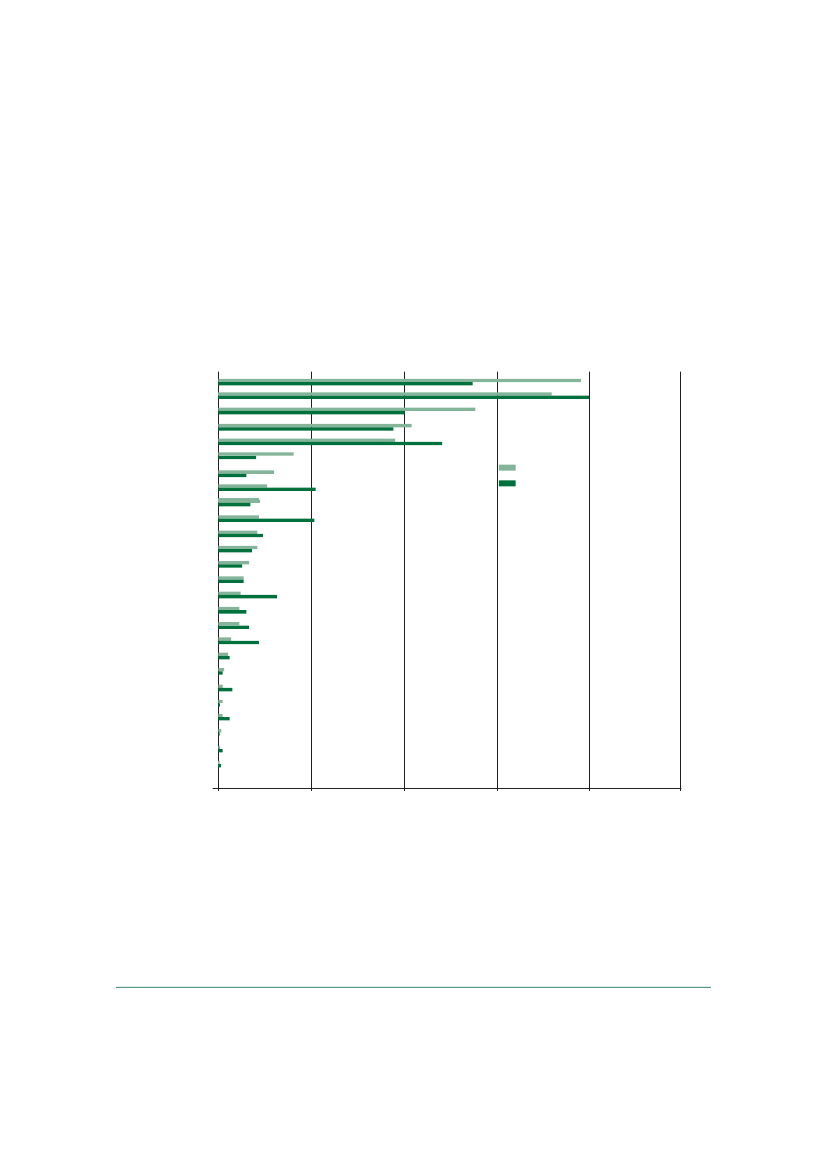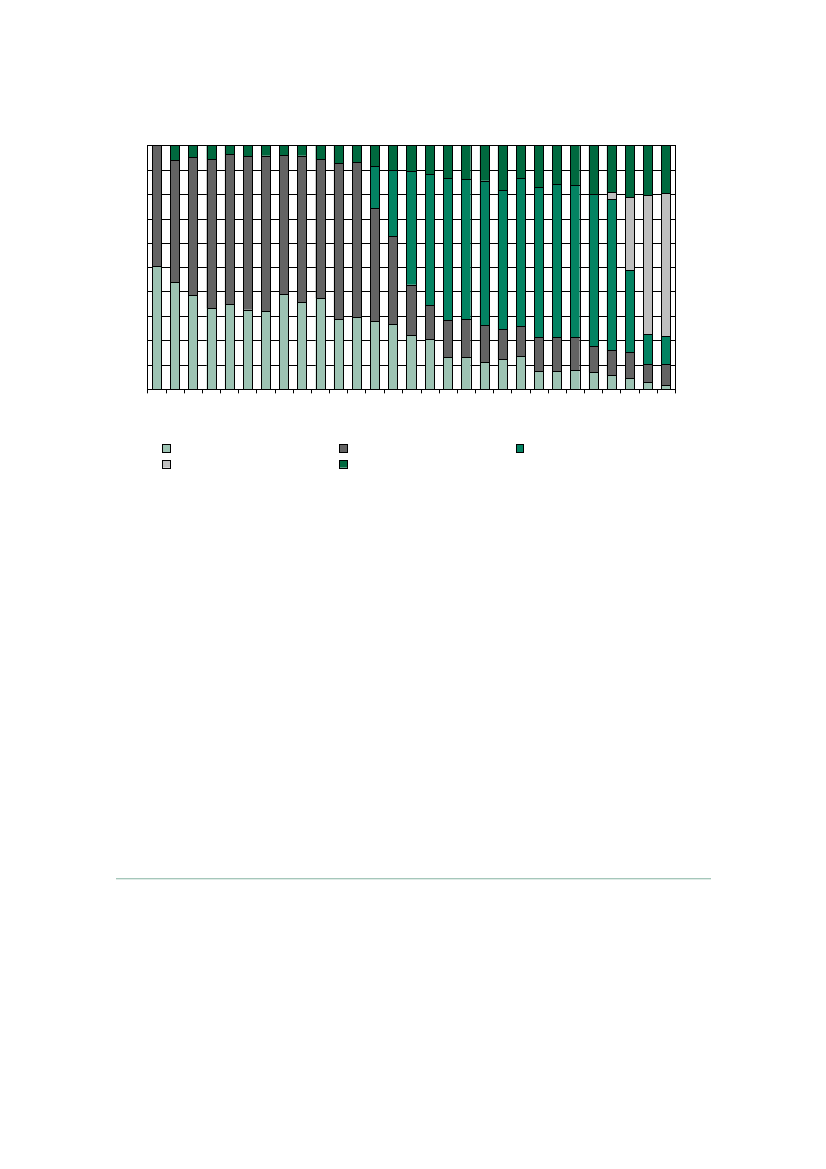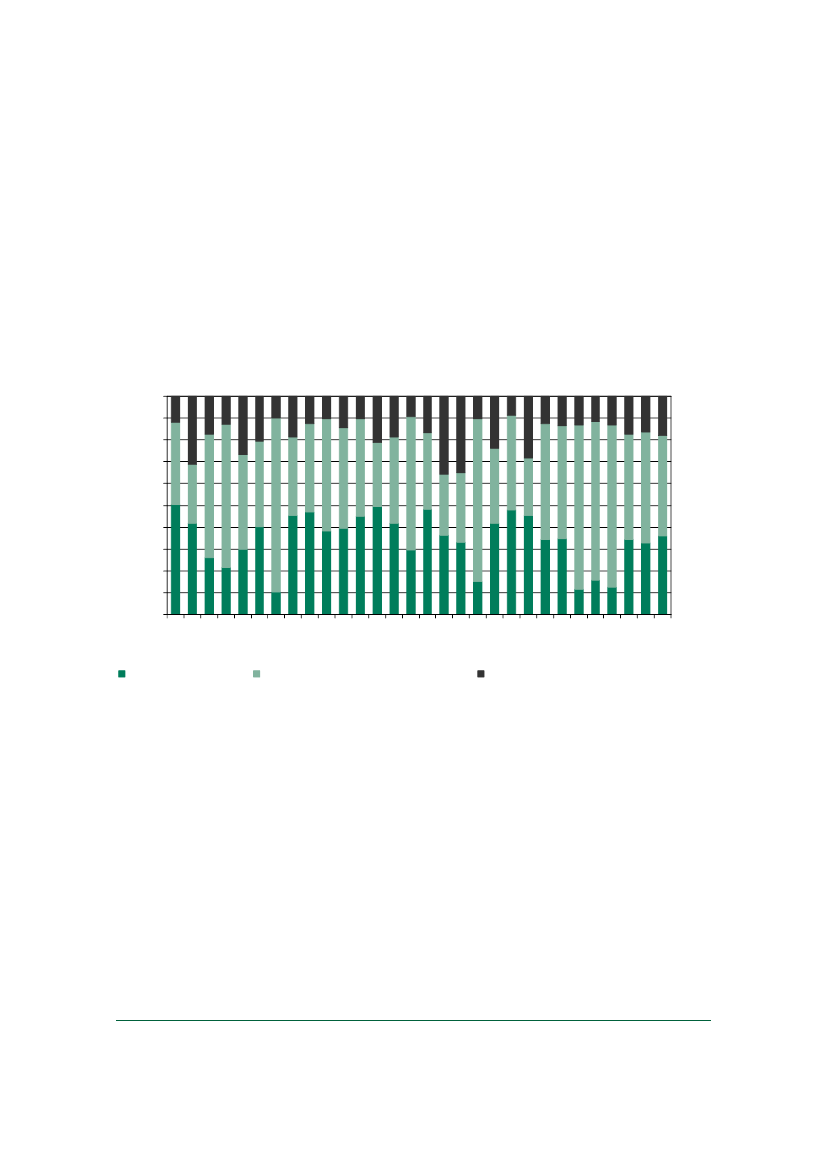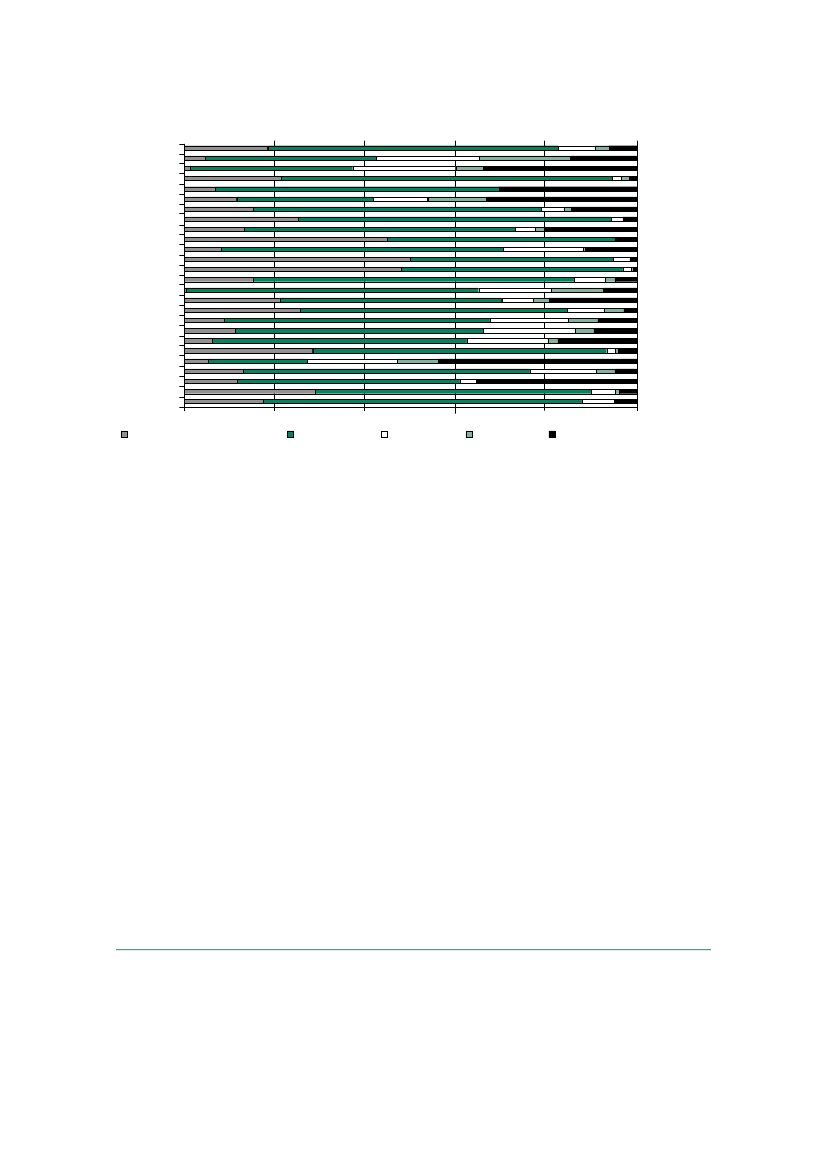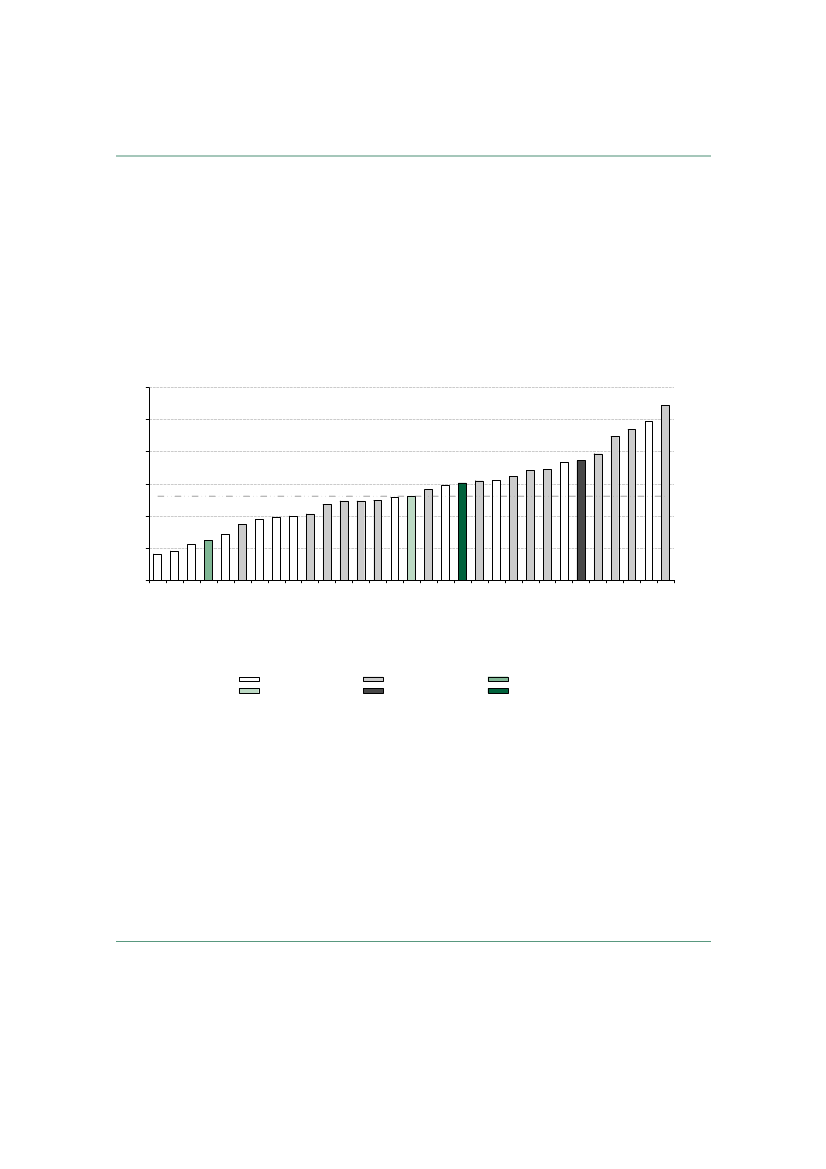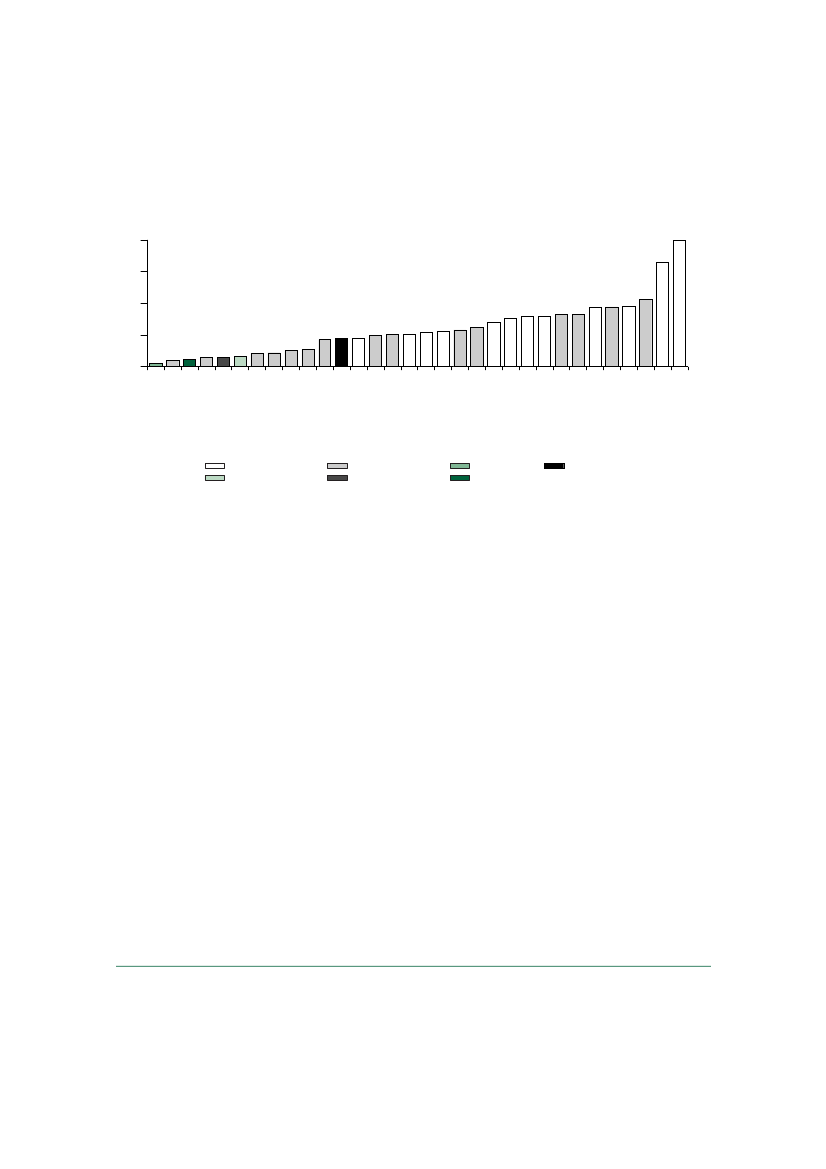Udvalget for Fødevarer, Landbrug og Fiskeri 2010-11 (1. samling)
FLF Alm.del Bilag 281
Offentligt
House of CommonsEnvironment, Food and RuralAffairs Committee
The CommonAgricultural Policyafter 2013Fifth Report of Session 2010–11Volume I: Report, together with formalminutes
Ordered by the House of Commonsto be printed 5 April 2011
HC 671-IPublished on 15 April 2011by authority of the House of CommonsLondon: The Stationery Office Limited£0.00
Environment, Food and Rural Affairs CommitteeThe Environment, Food and Rural Affairs Committee is appointed by the Houseof Commons to examine the expenditure, administration, and policy of theDepartment for Environment, Food and Rural Affairs and its associated bodies.Current membershipMiss Anne McIntosh (Conservative,Thirsk and Malton)(Chair)Tom Blenkinsop (Labour,Middlesborough South and East Cleveland)Thomas Docherty (Labour,Dunfermline and West Fife)Richard Drax, (Conservative,South Dorset)Bill Esterson (Labour,Sefton Central)George Eustice (Conservative,Camborne and Redruth)Barry Gardiner (Labour,Brent North)Mrs Mary Glindon (Labour,North Tyneside)Neil Parish (Conservative,Tiverton and Honiton)Dan Rogerson (LiberalDemocrat, North Cornwall)Amber Rudd (Conservative,Hastings and Rye)Nigel Adams (Conservative,Selby and Ainsty)and Mr David Anderson (Labour,Blaydon)were members of the Committee during this inquiry.PowersThe Committee is one of the departmental select committees, the powers ofwhich are set out in House of Commons Standing Orders, principally in SO No.152. These are available on the Internet via www.parliament.uk.PublicationsThe reports and evidence of the Committee are published by The StationeryOffice by Order of the House. All publications of the Committee (including pressnotices) are on the Internet atwww.parliament.uk/efracomCommittee staffThe current staff of the Committee are Richard Cooke (Clerk), Lucy Johnson(Second Clerk), Sarah Coe (Committee Specialist—Environment), Rebecca Ross(Committee Specialist—Agriculture), Clare Genis (Senior Committee Assistant),Jim Lawford and Anna Browning (Committee Assistants), and Hannah Pearce(Media Officer).ContactsAll correspondence should be addressed to the Clerk of the Environment, Foodand Rural Affairs Committee, House of Commons, 7 Millbank, London SW1P 3JA.The telephone number for general enquiries is 020 7219 5774; the Committee’se-mail address is: [email protected]. Media inquiries should be addressedto Hannah Pearce on 020 7219 8430.
The Common Agricultural Policy after 2013
1
ContentsReportSummary1IntroductionPurpose and Scope of the inquiryBackground to the Common Agricultural PolicyThe origin and evolution of the CAPThe current structure of the CAPPage
3568910131314151718192022242729313132323435363737373838394042
2
Objectives of the Common Agricultural PolicyThe need for a common policy on agricultureObjectives and priorities for the post-2013 CAPFood SecurityAgricultural CompetitivenessNatural resourcesFarmers’ incomesDiversity of farming systems
3
Drivers for reform of the CAPFuture agricultural policy and world trade
456
The budget of the CAP in the post-2013 financial frameworkThe Commission’s Communication: the CAP towards 2020The Single Payment Scheme post-2013Divergent perspectives on the future of direct paymentsArguments for the retention of direct paymentsPoor business conditions in agricultureEnsuring EU food securityDirect payments make EU farmers globally competitiveRewarding farmers for delivering public benefitsArguments against the retention of direct paymentsDirect payments do not make farming more competitiveThe Single Payment Scheme is not targetedMore money needs to be spent on the environmentCommercial prospects for agriculture are improvingConclusions on the future of the Single Payment SchemeDefra’s handling of the debate over the Single Payment Scheme
7
A more equitable distribution of funding
8 The balance of funding between direct payments and payments forenvironmental public goodsDoes the CAP need to be greener?The Commission’s proposals to ‘green’ Pillar 1
464648
2
The Common Agricultural Policy after 2013
9
Additional proposals for direct paymentsThe future of coupled paymentsTargeting of direct payments to active farmersCapping of paymentsSupport for small farmersSupport for Less Favoured Areas or Areas of Natural Constraint
5353545658596163646670717273
10 Increasing the competitiveness of EU agricultureResearch and Knowledge TransferImproving the functioning of the supply chainPrice volatility and market management measures
11 Simplification12 Defra’s handling of the response to the Communication13 Conclusion on the Commission’s Three OptionsConclusions and recommendations
Formal minutesWitnessesList of printed written evidenceList of additional written evidenceList of Reports from the Committee during the current Parliament
7980818183
The Common Agricultural Policy after 2013
3
SummaryThe Common Agricultural Policy (CAP) is again at a crossroads: decisions made now willdetermine our future food prices and availability and shape Europe’s countryside and ruralcommunities. This round of CAP reform is being played out against a very differentbackground to past reforms: food security is rising up the political agenda, placing arenewed emphasis on agricultural policy.The Coalition Government has committed to supporting UK agriculture and encouragingincreased production. Funds provided from the CAP are the centre-piece of UKagricultural spending. Defra must engage proactively in Europe to ensure that thereformed policy will deliver a more competitive, productive and sustainable UKagriculture, in line with its commitments.The primary objective of the Common Agricultural Policy should be to deliver foodsecurity for the EU including a significant degree of self-sufficiency. At the same time, theCAP should help farming businesses become more competitive and profitable and shouldmanage our natural resources sustainably, including maintaining agricultural activity inareas where it enhances our physical and cultural landscapes. Recognising the combinedchallenges of a growing world population, climate change, and environmental degradation,the future CAP must help farmers to produce more while having fewer adverse impacts onour natural environment.The European Commission has set out a range of options for the CAP after 2013. We arenot convinced that any of the options as they currently stand represent a good deal for theUK. In this report, we have set out what changes Defra should seek to achieve on behalf ofthe UK as a whole. We have focussed on the key issues for UK agriculture: the future ofdirect payments and the balance between supporting farmers and protecting theenvironment.We believe that direct payments have a place within the CAP, for as long as businessconditions in agriculture fail to deliver a thriving and profitable industry. While we shareDefra’s ambition to reduce reliance on subsidies, we are not convinced that simplyreducing direct payments is the way to achieve this. If Defra is to retain credibility, it mustset out exactly how UK farmers will become self-supporting, against a backdrop of risinginput prices and greater competition from third countries. In this context, we encourageDefra to clarify its own food security strategy, taking into account the recommendations ofthe Foresight report and its own position on the CAP.Our witnesses rejected the European Commission’s proposals to ‘green’ Pillar 1 throughcompulsory additional agri-environmental measures as they risk creating additionalcomplexity of implementation while not delivering tangible benefits. We agree that thefuture CAP should place greater emphasis on sustainable farming, but believe that this willbe more successful if farmers are encouraged by incentives rather than stifled by regulation.Additional agri-environmental measures must be directed at ‘win-wins’ forcompetitiveness and sustainability if they are to gain traction in the long-term. In principlewe agree that strengthening and expanding the agri-environment component of Pillar 2
4
The Common Agricultural Policy after 2013
would be more appropriate than establishing a new raft of measures in Pillar 1. However, ifUK farmers are not to be disadvantaged, there must be a common approach and acommon target for implementation across Europe. For this reason, we suggest Defraconsider whether full EU-financing would be more appropriate for measures that areintended to be applied across Europe.The Commission’s proposals are lacking in both vision and detail as to how it intends toincrease the competitiveness of EU agriculture. Elements of their proposals, such aspayment ceilings and additional support for small farmers, risk making UK businesses lesscompetitive. Defra should negotiate changes to these elements and ensure that the finallegislative proposals represent a clear plan for growth in EU agriculture. In particular, thefinal proposals must give fuller consideration to rectifying imbalances in the food supplychain and strengthening farm extension services and knowledge transfer. Any newdefinition of eligible recipients of CAP payments must not disadvantage the UK’s tenantfarmers and commoners.Defra’s handling of the debate over the future CAP has not impressed us thus far. We areconcerned that their stance on direct payments lacks clarity and may reduce their ability tonegotiate constructively with other Member States, or with the devolved administrations. Itis incumbent on Defra to ensure that the devolved administrations’ views are fairlyrepresented. We encourage Defra and the devolved administrations to produce a jointposition statement on the CAP post-2013 swiftly.
The Common Agricultural Policy after 2013
5
1Introduction1. Agriculture is the main land use in the European Union, covering nearly half of its landarea. The agri-food sector represents 8.6% of EU employment and 4% of the EU’s GDP.1The EU is one of the largest global exporters and importers of agricultural products: itsexport of agricultural goods, mainly high value or processed products, accounts for about17% of total global trade.2Consequently, the Common Agricultural Policy (CAP) is one ofmost important components of the European Union, both in terms of budget and itsimpact on the EU’s 500 million citizens. The CAP accounted for around 43% of the totalEU budget in 2010 (expected to fall to 39% by 2013), which is equivalent to about 0.45% ofthe EU’s GDP.3Through a combination of direct payments to farmers, measures toregulate agricultural commodity markets and grants for improving the environment, theCAP exerts significant influence over the European countryside and rural livelihoods, aswell as global food prices and availability. Moreover, as a key player in the World TradeOrganisation (WTO), the EU’s agricultural policy can shape global trade agreements.2. In 2006, the European Commission was invited by the Council of the European Unionto “undertake a full, wide-ranging review covering all aspects of EU spending, includingthe Common Agricultural Policy”.4Although there is no requirement to reform much ofthe underpinning legislation, the Commission has signalled its intention to carry out areview of the instruments within the CAP. Reform of the future CAP is proceeding intandem with negotiations over the next EU Financial Framework, which must be in placeby the end of 2013.53. The CAP has undergone periodic reform since its inception in 1957, with the overall aimof becoming more market-orientated and less trade-distorting, as well as maintainingdiscipline within the EU budget. This round of reform will be conducted against abackground of financial constraints in many Member States, including those that are majorrecipients of the CAP. The EU’s flexibility over its agricultural policy is further constrainedby existing WTO regulations and subsequent commitments that it has made during theDoha Development Round of trade talks.6In addition, concerns over food security aregiving a new gravity to agricultural policy.4. This is the first major CAP reform with 27 Member States, representing a greaterdiversity of farm structures and priorities. The accession of 12 Central and Eastern
12345
European Parliament resolution of 8 July 2010 on the future of the Common Agricultural Policy after 2013(TA(2010)0286), para F.Ibid,para P.Ibid,para U; Ev 170.Official Journal of the European Union,C 139, 14 June 2006, p 15.In October 2010, the Commission published its review of the EU Budget (Communication from the Commission tothe European Parliament, the Council, the European Economic and Social Committee, and the Committee of theRegions,The EU Budget Review,COM(2010) 700 final, 19 October 2010). The Commission must present its proposalsfor the next Multiannual Financial Framework before 1 July 2011.The Doha Development Round is a round of world trade talks organised by the World Trade Organisation (WTO)with the aim of negotiating changes to the General Agreement on Trade and Tariffs that was agreed in 1993 at theconclusion of the Uruguay Round. The Doha Round talks have been stalled since 2008, but the WTO is drafting newtexts with the hope of restarting talks this year (“Doha talks running at snail’s pace, agree negotiators”,AgraEurope,11 March 2011).
6
6
The Common Agricultural Policy after 2013
European Countries after 2003 brought an extra seven million farmers into the EU.7Anadditional and unpredictable factor is that, under the 2009 Lisbon Treaty, the EuropeanParliament will now have joint decision-making powers with the Council of the EuropeanUnion. This may make the negotiating process more transparent, but also more complex.Reconciling the varying objectives of 27 Member States and the European Parliament willunquestionably be a political challenge for the EU.5. The European Commission initiated the dialogue over the ‘CAP post-2013’ with a publicconsultation held over the summer 2010,8followed by a Communication onThe CAPtowards 2020published in November 2010.9The Agriculture and Fisheries Councilproduced initial conclusions on the Communication in March 2011; however, these failedto win unanimous support from Member States.10The European Parliament is expected topass a resolution in response to the Commission’s Communication in June 2011. Further,more detailed legislative proposals are expected in autumn after the proposals for the post-2013 EU Multiannual Financial Framework have been published. The Commission hopesto conclude negotiations on the CAP by the end of 2012 to allow one year forimplementation.6. This Committee has a long-standing interest in CAP reform. The previousEnvironment, Food and Rural Affairs Committee published reports on theUKGovernment’s Vision for the Common Agricultural Policyin 2006,Implementation of CAPReform in the UKin 2004, andThe Mid-Term Review of the Common Agricultural Policyin2003, as well as scrutinising the work of the Rural Payments Agency.11
Purpose and Scope of the inquiry7. In this inquiry we have scrutinised the Commission’s proposals in light of UK interestsin particular.12Defra is going into negotiations on the CAP that will determine our futurefood prices and availability and shape Europe’s countryside and rural communities until2020, or beyond. Our recommendations and analysis set out where we believe the limits toDefra’s negotiating position should be.7European Parliament resolution of 8 July 2010 on the future of the Common Agricultural Policy after 2013(TA(2010)0286), para G. Specifically, the EU was enlarged in 2004 to include: Hungary, Poland, Slovakia, Latvia,Estonia, Lithuania, the Czech Republic, Slovenia. Bulgaria and Romania acceded in 2007.The public consultation was concluded with a public conference in July 2010. A summary of the responses to theconsultation together with a video recording of the conference can be viewed on the European Commission’sAgriculture and Rural Development website: http://ec.europa.eu/agriculture/Communication from the Commission to the European Parliament, the Council, the European Economic and SocialCommittee, and the Committee of the Regions,The CAP towards 2020: Meeting the food, natural resources andterritorial challenges of the future,COM(2010)672/5; hereafter “the Communication”.Council of the European Union,Presidency conclusions on the communication from the Commission: The CAPtowards 2020: meeting the food, natural resources and territorial challenges of the future,3077thAgriculture andFisheries Council meeting, 17 March 2011, www.consilium.europa.eu. Seven Member States voted against thedocument: Denmark, Sweden, the UK, Latvia, Lithuania, Estonia and Malta. “Latest EU Farm Council Wrap”,AgraEurope,17 March 2011.The UK Government’s “Vision for the Common Agricultural Policy”,Fourth Report of Session 2006–07, HC 456;TheRural Payments Agency and the Implementation of the Single Payment Scheme,Third Report of Session 2006–07, HC107;The Implementation of CAP Reform in the UK,Seventh Report of Session 2003–04, HC 226;Rural PaymentsAgency,Sixth Report of Session 2002–03, HC 382;The Mid-Term Review of the Common Agricultural Policy,ThirdReport of Session 2002–03, HC 151.The terms of reference are available on the Committee’s website:http://www.parliament.uk/business/committees/committees-a-z/commons-select/environment-food-and-rural-affairs-committee/inquiries/cap-reform/
8
9
10
11
12
The Common Agricultural Policy after 2013
7
8. The CAP is a convoluted policy, having been moulded to fit the multifarious wishes ofgovernments and Agriculture Commissioners over the years. Since the Treaty of Rome in1957, the requirements of EU agricultural policy have shifted, notably with a muchstronger focus on preserving natural resources, while our future policy will have to meetthe challenges of food security and climate change. For this reason, we start with a freshanalysis of the CAP’s objectives towards 2020 (Chapter 2) and the internal and externalfactors to take account of when shaping the new CAP (Chapter 3).9. The overall size of the CAP budget and the way that it is distributed between MemberStates will be one of the most important issues for the UK. We give consideration to high-level issues surrounding the CAP budget in Chapter 4. However this report precedes EU-level discussions on the Multiannual Financial Framework post-2013, precluding detailedanalysis.10. The UK tends to take a reformist stance on the CAP, having argued for over ten yearsthat direct payments and market support should be phased out in favour of increasedspending on targeted measures to protect the environment.13This places us in a minoritywithin Europe, particularly compared to influential old Member States such as France andGermany. It is already clear that the future of direct payments will be the central issue inthe debate over the post-2013 CAP. We address the nature and distribution of directpayments from a UK perspective in Chapters 6 and 7. In Chapter 8, we scrutinise theCommission’s ideas for legitimising the CAP by bringing agri-environment measures intoits core policy.11. Turning to the substance of the Commission’s Communication, the proposals torestrict payments to active farmers, to give more support to small farmers and to cappayments to large farmers were highlighted by many of our witnesses as issues ofimportance to the UK. We discuss these and other specific elements of the proposals inChapter 9. Reflecting Defra’s aim to deliver a thriving farming sector, we then discuss waysin which the CAP can enhance the competitiveness of UK agriculture (Chapter 10) andreduce red-tape for farmers and administrations (Chapter 11).12. We announced this inquiry on 4 November 2010. We held seven oral evidence sessionsand heard from 14 organisations or individuals including farming groups, environmentalNGOs, the European Commissioner for Agriculture and Rural Development and Rt HonJames Paice, the Minister of State for Agriculture and Food (a full list is given at the end ofthe report).We received written evidence from 34 individuals or organisations. We alsotook part in a visit to Brussels to discuss aspects of CAP reform. We are very grateful to allthose who helped us with our inquiry. This report is necessarily limited to the details givenin the Commission’s Communication. This is a rapidly moving area and additional detailsof the proposals have emerged between evidence-taking and publication of this report.
13
Cunha and Swinbank,An inside view of the CAP reform process,2011, p 121; Defra and HM Treasury,A Vision forthe Common Agricultural Policy,December 2005; Defra,UK Response to the Commission Communication andConsultation: “The CAP towards 2020: Meeting the food, natural resources and territorial challenges of the future”,January 2011.
8
The Common Agricultural Policy after 2013
Background to the Common Agricultural Policy13. The Common Agricultural Policy sets out the EU’s common approach to agricultureand its system of payments. It is structured around three groups of instruments: directpayments, market measures and rural development.14The CAP receives 98% of the EU’sPreservation and Management of Natural Resources budget, which was allocated €416bnfor the 2007–2013 Financial Perspective.15In 2010, the UK’s contribution to the EUaccounted for 10.4% of the CAP budget and the UK’s share of the allocation for directpayments was 9.5%. France contributed about 18.0% of the CAP budget and receivedabout 20.1% of the direct payments allocation. Greece contributed 2.2% and received 5.2%(Figure 1).16Figure 1: Member States relative contributions and receipts from the CAPGermanyFranceItalyUnited KingdomSpainNetherlandsBelgiumPolandAustriaGreeceDenmarkSwedenFinlandPortugalIrelandCzech RepublicRomaniaHungarySlovakiaSlovenaBulgariaLuxembourgLithuaniaCyprusLatviaEstoniaMalta
ContributionsReceipts
0.63%0.67%0.34%0.25%0.32%0.80%0.27%0.09%0.25%0.65%0.16%0.09%0.16%0.25%0.12%0.17%0.05%0.01%
0%
5%
10%
15%
20%
25%
Source: European Parliament (2010/117/EU), Definitive adoption of the European Union’s general budget for thefinancial year 2010, p 20; Council Regulation (EC) No 73/2009, Annex VIII. The graph shows Member States’receipts from Pillar 1 of the CAP in 2010 as a percentage of the total budget for Pillar 1 and Member States’contributions based on the relative share of each country’s payments to the EU Budget. Pillar 2 is not included.
141516
There are some additional programmes directed by the Commission such as plant and animal health inspections andpromoting fruit in schools.European Commission,European Union Public Finance (Fourth Edition),2008.European Parliament (2010/117/EU),Definitive adoption of the European Union’s general budget for the financialyear 2010,p 20; Council Regulation (EC) No 73/2009, Annex VIII.
The Common Agricultural Policy after 2013
9
The origin and evolution of the CAP14. The Common Agricultural Policy was established in the aftermath of the SecondWorld War, following a long period of rationing and food shortages. As a result, a keydriver of the original CAP was enhancing self-sufficiency through boosting domesticproduction; to facilitate this, European prices for agricultural commodities weremaintained at levels in excess of the world market. Market price support required acombination of high import tariffs, intervention buying and export subsidies.15. As yields and production rose, the requirement for public storage (the ‘wine lakes’ and‘butter mountains’) and for subsidies for exporting excess goods also increased. This hadnegative implications for the perception of the CAP among EU citizens and ininternational trade negotiations—disagreements over agricultural support were one of thefactors leading to the collapse of the WTO Uruguay Round trade negotiations in December1990. Moreover, the cost of the CAP almost trebled between 1980 and 1992.1716. The 1992 MacSharry reforms aimed to reduce expenditure on the CAP and removesome of the incentives for farmers to over-produce. Payments were decoupled fromproduction for cereals and beef and the intervention prices for cereals, dairy and beef werereduced. Direct payments for cereals and beef, known as the Single Farm Payment, werebrought in to compensate producers for the resulting loss of income. For the first time,measures to support rural economic diversification and environmental protection wereincluded in the CAP.17. The Agenda 2000 reforms, agreed in 1999, were inspired by preparations for the policyand budgetary consequences of the Central and Eastern European Countries (CEECs)joining the EU. These reforms included further reduction of the intervention prices,extension of the dairy quota and the establishment of the rural development regulation.Modulation, which is a transfer from the single farm payment to fund rural development,was introduced on a voluntary basis.18. The 2003 Mid-term Review of the Agenda 2000 package, also known as the FischlerReforms, is generally considered to be the most radical of the CAP reforms in that itdecoupled farm income support from production in most sectors (Figure 2).18The FischlerReforms also made it compulsory for recipients of the Single Farm Payment to meetenvironmental and animal welfare standards. In 2002, the Council agreed to limit CAPspending on Pillar 1 at its 2006 levels for the financial perspective to 2013. The 2008 HealthCheck consolidated the Fischler reforms through decoupling the remaining sectors (exceptthe suckler cow, goat and sheep premia) and confirming the abolition of milk quotas in2015. The requirement for farmers to keep 10% of their land in set-aside was abolished.19. The percentage of the EU budget spent on the CAP has fallen from a high point ofabout 75% in the mid 1980s to under 40% by 2013, even though the agricultural land areahas increased by 40% following the 2004 and 2007 enlargements of the EU.19
171819
Cunha and Swinbank,An inside view of the CAP reform process,2011, p 69.Member States were given the option to retain some coupled payments for both cereals and livestock.European Parliament resolution of 8 July 2010 on the future of the Common Agricultural Policy after 2013(TA(2010)0286), para U.
10
The Common Agricultural Policy after 2013
Figure 2: The evolution of CAP expenditure100%90%80%70%60%50%40%30%20%10%19801981198219831984198519861987198819891990199119921993199419951996199719981999200020012002200320042005200620072008
0%
Export subsidiesDecoupled direct payments
Other market supportRural development
Coupled direct payments
Data source: European Parliament Committee on Agriculture and Rural Development, Report on the future of theCommon Agricultural Policy after 2013, 21 July 2010, A7-0204/2010, p25
20. Awareness of the CAP’s history is an important part of understanding its current logic.Direct payments, the main element of the CAP, were brought in initially as compensationfor policy changes that disadvantaged producers. Over time they have acquired newfunctions, and, through being extended to the new Member States, have arguably becomemore entrenched within the CAP than was originally envisaged.The current structure of the CAP21. Direct payments and market measures make up Pillar 1 of the CAP and are fullyfinanced from the European Agriculture Guarantee Fund (EAGF).20Pillar 1 accounts forabout 80% of CAP spending.21Rural development programmes make up Pillar 2 of theCAP and are co-financed by the European Agricultural Fund for Rural Development(EAFRD) and national governments.22The UK is the fifth largest recipient of directpayments but has one of the smallest shares of the rural development fund.23
20
Regulation (EC) No 1290/2005 on the financing of the common agricultural policy established a common legalframework for CAP spending. Regulation (EC) No. 1234/2007 describes the organisation of the common market inagricultural products. Regulation (EC) No 73/2009 established common rules for direct support schemes and certainsupport schemes for farmers under the common agricultural policy.Pillar 1 was allocated about €313bn for the Financial Perspective 2007–2013 and Pillar 2 €96bn (after modulation).There are other smaller funds in Heading 2, such as the European Fisheries Fund and LIFE+. Source: EuropeanCommission,Investing in our future: the European Union’s Financial Framework 2007–2013,June 2010, p 5.Regulation (EC) No 1698/2005 on support for rural development by the European Agricultural Fund for RuralDevelopment (EAFRD).During 2007–2013 the UK is projected to receive €23.6bn in direct payments, accounting for approximately 8.5% ofthe EU total post-modulation (the exact figures will vary). Over the same period, the UK will receive €2bn, or about2% of the Pillar 2 budget. Sources: Commission Decision of June 2007 (2007/383/EC); Defra,Rural DevelopmentProgramme for England 2007–2013 Programme Document,2007, informal briefing from Defra.
21
2223
The Common Agricultural Policy after 2013
11
22. Direct payments are principally decoupled from production and take the form of theSingle Payment Scheme (SPS). SPS entitlements must be matched to eligible land. Thepayment is called the Single Farm Payment (SFP) in the EU-15 Member States.24Themethod by which the SFP is calculated varies among the EU-15, either historic or area-based. In historic systems, the payment depends on the individual farmer’s receipts in thereference period 2000–02. In area-based systems, a flat rate is paid per hectare and the rateis based on the subsidies received by farmers in the region during the reference period.England opted for a ‘dynamic hybrid’ system, shifting individual recipients from a historicto a regional per hectare basis over a number of years. Scotland and Wales retained thehistoric system and Northern Ireland uses a static hybrid system. In most of the new EU-12Member States, payment is calculated on a flat rate per hectare system, which is called theSingle Area Payment Scheme (SAPS).2523. In return for receipt of the direct payment, the farmer must keep his land in GoodAgricultural and Environmental Condition (GAEC) and meet the Statutory ManagementRequirements (SMRs). This is known as cross-compliance. SMRs are determined byexisting EU legislation, while GAEC is defined by the Member States.26Under EUregulations, at least 1% of farmers receiving direct payments must be inspected annually toensure they are compliant, and fines are imposed for infractions.2724. Pillar 2 funds three types of activity (called Axes):••
Axis 1: Improving the competitiveness of agriculture and forestry, for example grantsfor new machinery.Axis 2: Improving the environment and countryside, mainly through agri-environmentschemes. The CAP provides the majority of funding for environmental protection inEurope.28
•
Axis 3: Improving the quality of life in rural areas and diversification of the ruraleconomy, such as grants to help farmers to diversify or to establish information centresto encourage tourism.25. Each Member State can choose how to allocate its Pillar 2 budget as long as at least 10%is spent on Axes 1 and 3 and 25% on Axis 2. The Commission has stipulated over 40
24
The ‘old Member States’, also known as the EU-15, comprise Germany, France, Italy, the Netherlands, Belgium,Luxembourg, Denmark, Ireland, United Kingdom, Greece, Spain, Portugal, Austria, Finland and Sweden. The ‘newMember States’, or the EU-12, are those states that joined after 2003, which are: Czech Republic, Cyprus, Estonia,Latvia, Lithuania, Hungary, Malta, Poland, Slovenia, Slovakia, Bulgaria and Romania. Different mechanisms are usedin the old and new Member States because the EU-12 acceded after the 2003 Fischler reforms established the SingleFarm Payment.In this report, the term ‘Single Payment Scheme’ will refer to the system of deciding the level of direct payments andthe Single Farm Payment (SFP) will mean the actual payment received by farmers.Examples of Statutory Management Requirements include regulations on water pollution in Nitrate VulnerableZones, protection of the habitats of wild birds and other vulnerable species, regulations on livestock identificationand movement. GAEC standards include crop-rotation, maintaining terraces, minimum livestock densities, bufferstrips next to watercourses, and hedgerow management. A guide to cross compliance in England is available fromwww.crosscompliance.org.ukIn England, separate inspections are performed by the Rural Payments Agency, Environment Agency and the AnimalHealth and Veterinary Laboratories Agency (AHVLA) to check different aspects of cross-compliance. The RuralPayments Agency (RPA) imposes a fine of 3% of the SFP for the first breach.The main other EU financial instrument for the environment is LIFE+, which was allocated about€2.2bnbetween2007–2013. Source: European Commission,Investing in our future: the European Union’s Financial Framework 2007–2013,June 2010, p 5.
2526
27
28
12
The Common Agricultural Policy after 2013
measures that can be applied, from which Member States can choose which to fund.29Inthe UK, the choice of measures funded by the rural development programme is a devolvedissue.26. There is considerable disparity between Member States in terms of their allocation todifferent objectives within Pillar 2. England, under the previous Government, opted tospend about 80% of its total rural development programme budget (the RuralDevelopment Programme for England—RDPE) on Axis 2 agri-environment schemes (theEnvironmental Stewardship schemes), and about 10% each on improving the vitality ofrural areas and competitiveness.30In comparison, the EU-wide average is about 50% onAxis 2 (environment) and 33% on Axis 1 (competitiveness) (Figure 3).Figure 3: Relative importance of the three thematic RD axes by Member State for the programmingperiod 2007–2013100%90%80%70%60%50%40%30%20%10%0%
HL
AT
PL
PT
RO
SI
SK
FI
SE
EU-27
EU-15
Axis 1: Competitiveness
Axis 2: Environment and land management
Axis 3: Quality of life and diversification
Data source: European Commission, Agricultural Policy Perspectives Briefs, No. 1, January 2011, p5
2930
Council Regulation (EC) No 1698/2005 of 20 September 2005 on support for rural development by the EuropeanAgricultural Fund for Rural Development (EAFRD).EFRA Committee,Farming in the Uplands,Third Report of Session 2010–11, HC 556, Ev 45.
EU-12
MT
BG
DK
DE
CY
HU
UK
EL
BE
EE
ES
FR
CZ
IE
IT
LV
LT
LU
The Common Agricultural Policy after 2013
13
2Objectives of the Common AgriculturalPolicy27. The original objectives of the Common Agricultural Policy were set out in the Treatyestablishing the European Economic Community (also known as the Treaty of Rome) in1957. They were retained in the Treaty on the Functioning of the European Union (TFEU)(Box 1).Box 1: Article 39 of the Treaty on the Functioning of the European Union (TFEU)The objectives of the common agricultural policy311. The objectives of the common agricultural policy shall be:(a) to increase agricultural productivity by promoting technical progress and by ensuring therational development of agricultural production and the optimum utilisation of the factors ofproduction, in particular labour;(b) thus to ensure a fair standard of living for the agricultural community, in particular byincreasing the individual earnings of persons engaged in agriculture;(c) to stabilise markets;(d) to assure the availability of supplies;(e) to ensure that supplies reach consumers at reasonable prices.
The need for a common policy on agriculture28. When the Treaty of Rome established the Common Market, there was strong stateintervention in agriculture in the six founding Member States. If agricultural produce wasto be included in the free movement of goods while maintaining state intervention,national intervention mechanisms had to be made compatible across the Community. Thisis the basic purpose on which the common agricultural policy was founded and remainsvalid today.32Dr Moss, Principal Agricultural Economist at the Agri-Food and BiosciencesInstitute (AFBI) and Senior Lecturer at Queen’s University, Belfast, stated “measures whichimpact on the functioning of the markets for agricultural commodities should remaincommon”.33The Commission’s Communication states that the “overwhelming majority ofviews expressed [in response to their public consultation] concurred that the future CAPshould remain a strong common policy.34A Eurobarometer survey conducted in early2010 concluded there was “an overall preference for the European level to manageagricultural issues”.35
31
Official Journal of the European Union,C115, 9 May 2008, p 62. The Treaty of Lisbon, which entered into force on 1December 2009, amended the Treaty establishing the European Community, which was renamed the Treaty on theFunctioning of the European Union.European Parliament Fact Sheet 4.1.1The Treaty of Europe and Green Europe.Ev 126The CAP towards 2020,p 2.TNS Opinion and Social on behalf of the European Commission,Europeans, Agriculture and the CommonAgricultural Policy—Summary Report,Special Eurobarometer 336, March 2010. It should be noted that only 57% ofthose surveyed had heard of the Common Agricultural Policy.
32333435
14
The Common Agricultural Policy after 2013
29. It is asserted, through the subsidiarity principle, that EU-level action is justified onissues that cross national borders.36Agricultural policy influences several supra-nationalissues, such as food security (as agricultural products move freely within the EU), thepreservation of natural resources and biodiversity (although specific habitats might bedeemed a local issue), and tackling climate change. For the same reason, a common EUagricultural policy is desirable for the purpose of international trade negotiations, givingMember States greater influence than they would have as lone entities.30. Member States are likely to differ in the priority that they place on agriculture and ruraldevelopment. The potential for distortion of competition because some producers aresupported more than others increases the more CAP expenditure or policy is determinednationally or is co-financed. The Andersons Centre claimed that UK farmers would beplaced at a disadvantage if more funding was decided nationally as “the UK Treasurywould strongly resist providing funds”.37Several other witnesses agreed that a‘renationalisation’ of the budget could harm UK farmers’ competitiveness.3831.Given the strategic importance of food and the openness of markets within the EU,it is essential that the EU retains a common policy on agriculture. First, this helps tomaintain fair competition for agricultural products within the EU. Second, agriculturalpolicy affects cross-border issues such as food security and climate change where actionat a supra-national level is appropriate. Third, through acting collectively, the EU isable to be a major player in global agricultural trade.
Objectives and priorities for the post-2013 CAP32. The Commission’s Communication gives three overall objectives for the future CAP,and several sub-objectives within each main objective (Box 2).Box 2: The Commission’s objectives for the future CAP39Objective 1: Viable food production•to contribute to farm incomes and limit farm income variability•to improve the competitiveness of the agricultural sector and to enhance its value share in thefood chain•to compensate for production difficulties in areas with specific natural constraints because suchregions are at increased risk of land abandonmentObjective 2: Sustainable management of natural resources and climate action•to guarantee sustainable production practices and secure the enhanced provision ofenvironmental public goods•to foster green growth through innovation•to pursue climate change mitigation and adaptation actions
363738
European Parliament Fact Sheet 1.2.2Subsidiarity.Ev w28For example, the Tenant Farmers Association (TFA) (Ev 110), the Royal Society for the Protection of Birds (RSPB) (Ev107), Dr Moss, Principal Agricultural Economist, Agri-Food and Biosciences Institute (AFBI) and Senior Lecturer,Queen’s University, Belfast (Ev 124), the National Assembly for Wales Rural Development Sub-Committee (Ev w23),the Welsh Assembly Government (Ev w31), the Scottish Agricultural College (Ev w35).The CAP towards 2020,p 7.
39
The Common Agricultural Policy after 2013
15
Objective 3: Balanced territorial development•to support rural employment and maintaining the social fabric of rural areas•to improve the rural economy and promote diversification•to allow for structural diversity in the farming systems, improve the conditions for smallfarmers and develop local markets
33. Although witnesses agreed the need for a common policy, we received mixed viewsabout the objectives of the policy in future, ranging from maintaining farmers’ incomesthrough providing food security to protection of the environment and rural landscapes. Inthe following section, we present the views of UK interested parties on the purpose of theCAP and recommend a set of objectives and priorities for our agricultural policy.Food Security34. Our predecessor Committee in their inquirySecuring food supplies to 2050: thechallenge for the UKnoted the difficulty with defining ‘food security’.40For some, foodsecurity is simply about access to enough food, for others it is synonymous with self-sufficiency or even food sovereignty.41In this report, we concur with our predecessors thatfood security is ‘to have access at all times to sufficient, safe, sustainable and nutritiousfood, at fair prices, so as to help ensure an active and healthy life’.4235. The urgent need to address the food security question has been impressed on theCommittee by the recent Foresight report,the Future of Food and Farming.43This reportconfirmed the UN Food and Agriculture Organisation (FAO)’s predictions that foodsupplies will need to double to meet the predicted demands of 8–10 billion people by 2050,without bringing more land into production. Moreover, this “growing demand for foodmust be met against a backdrop of rising global temperatures and changing patterns ofprecipitation”.44We also note the conclusions of theSecuring food supplies to 2050inquirythat: “Doing nothing to contribute to the world's food supplies would be morallyunacceptable: at a time when a fundamental shift in thinking is required, the UK should setan example, not bury its head in the sand”.4536. This does not mean that we should use the CAP as a tool to increase EU productionnow beyond the level suggested by market conditions, which would be a return to post-warlogic. The National Farmers’ Union (NFU) claim that UK self-sufficiency in all food-groups (including for example tropical fruits that cannot be grown here) will fall from 59%
4041
EFRA Committee, Fourth Report of Session 2008–09,Securing food supplies up to 2050: the challenges faced by theUK,HC 213.Food sovereignty as a term was coined by the Via Campesina in 1996. It encompasses the idea that people shouldhave a right to locally produced and culturally appropriate food and to define their own food production systems(www.foodsovereignty.org)EFRA Committee,Securing food supplies up to 2050: the challenges faced by the UK,para 6.Foresight and Government Office for Science,The Future of Food and Farming: Challenges and choices for globalsustainability—Final Project Report,January 2011, p 15. Further information on the ForesightGlobal Food andFarming Futuresproject is available from their website, www.bis.gov.uk/foresightThe Future of Food and Farming,p 15.Securing food supplies up to 2050: the challenges faced by the UK,para 47.
4243
4445
16
The Common Agricultural Policy after 2013
to under 50% by 2030 if current trends continue.46However, we should not strive for totalself-sufficiency as this would be impossible with our current diets. The UK is currently 72%self-sufficient in domestically-produced foods, which are more relevant to our basic foodsecurity in terms of calorific intake than self-sufficiency over all food groups.47TheFutureof Food and Farmingreport rejected food self-sufficiency but emphasised that food systemgovernance needed to be improved as well, for example to avoid the introduction of exportbans at times of food stress.4837. There was a broad consensus among witnesses that the strategic importance of foodjustified Government intervention through agricultural policy to ensure food security; formany this includes retaining a significant degree of self-sufficiency, at least until globalgovernance of the food system has been improved.49For example, Dr Moss said:I think it is important that Europe retains a significant degree of self-sufficiency infood for strategic reasons. Very simply [...] we can opt not to buy a motor car, we canopt not to have fancy clothes or live in fancy houses, but food is of absoluteimportance; imperative importance.5038. Food security involves a balance between production and sustainability. Our futurefood security depends on sustainable management of the land and preservation ofagricultural social capital.51The Minister of State for Agriculture and Rural Developmenttold us that it was in the EU’s strategic interest to increase food production capacity,pointing out that climate change projections suggest that “northern Europe will beincreasingly the bread basket of the world”.5239.We believe that the EU will need to play a greater role in meeting food supplychallenges in the future, particularly as future climate change may result in currentlyproductive areas becoming less so. Until failures in the global governance system offood supply are addressed, there remains a strategic interest for the EU to retain asignificant degree of food self-sufficiency. The first objective of the CommonAgricultural Policy should be to maintain or enhance the EU’s capacity to produce safeand high-quality food.
46474849
“Take action now to avoid food shortage—NFU”,Farmers Guardian,31 December 2010.HC Deb, 18 October 2010, c425WThe Future of Food and Farming–Final Project report,p 19–20.For example, the RSPB (Q 8), TFA (Ev 111, Q 40, Q 58), the Country Land and Business Association (CLA) (Q 78), theNational Farmers’ Union (Q 124–125, Q 157), George Lyon MEP (Q 297), Brian Pack OBE (Q 342), the Agriculture andHorticulture Board (AHDB) (Ev 161, Q 362), the Food and Drink Federation (Ev 168, Q 398), Mr James Paice, Ministerof State for Agriculture and Food (Q 480), the Scottish Agriculture College (Ev w35), Farmers’ Union of Wales (Evw45). See also the European Parliament resolution of 8 July 2010 on the future of the Common Agricultural Policyafter 2013 (TA(2010)0286), para 6, 10–11, 67. The previous EFRA Committee concluded in theirSecuring foodsupplies to 2050report that the UK should not take world food supplies “for granted” and that “A healthy domesticagriculture is an essential component of a secure food system in the UK” (para 47).Q 218See Dr Moss (Q 232), the RSPB (Ev 108), the CLA (Ev 117–118), the Society of Biology (Ev w 19).Q 480. The AHDB similarly said that “the UK is predicted to be less impacted on by climate change than many othercountries meaning that our contribution to total food and crop production may potentially need to be greater inthe future than at present”. (Ev 161).
505152
The Common Agricultural Policy after 2013
17
Agricultural Competitiveness40. The European Commission believes that improving the viability of EU agriculture in aglobal market is central to the first objective of maintaining production capacity:On the one hand, agriculture can potentially contribute substantially to many of thechallenges faced by Europeans with right incentives and in the right setting [...] Onthe other hand, its structure is diverse and economic situation fragile [...] In effect,short-term survival dominates the perception of many farmers over the long-term,broader perspective. If agricultural policy does not address the former, it will havelittle success in promoting the latter.5341. In the UK, agriculture accounts for a relatively small proportion of the workforce andGDP (about 0.5% of Gross Value Added.54) However, it contributes significantly to otherparts of the economy: for example food and drink processing is the UK’s largestmanufacturing sector and buys two-thirds of the production of British farmers.55TheGovernment wants to rebalance the economy away from services and the financial sectortowards manufacturing. UK agriculture could be important in achieving this through itsrole in supporting the UK agri-food industry.5642. The UK Government and devolved administrations consider improving the overallcompetitiveness and viability of UK agriculture to be key aims of the CAP. The WelshAssembly Government wanted a CAP that “strengthens the competiveness of our landbased industries”,57and the Scottish Executive also aims to “optimise the productive use ofnatural resources”.58Defra called for “transformational reforms which we believe arenecessary to deliver a thriving, sustainable and internationally competitive EU farmingsector” in order to reduce reliance on public subsidies.59Farming representatives andenvironmental NGOS also agreed with the need to tackle the issue of farm businesscompetitiveness.6043.Enhancing the competitiveness and viability of the EU agricultural sector should bethe second objective of the CAP. A competitive and viable EU agricultural sector is thekey to producing more while having less impact on the environment and to reducingfarmers’ reliance on income support from the tax-payer in the long-term.
535455
European Commission,The reform of the CAP towards 2020: Consultation Document for Impact Assessment,2010.Defra,Agriculture in the United Kingdom,2008. Gross Value Added (GVA) of farmers and primary producers was£5.8bn, while GVA of the agri-food sector (including catering and retail) was £85bn, which is 6.7% of national GVA.Ev 167. It has been estimated that, in Scotland, one job in agriculture supports 0.85 jobs elsewhere in the ruraleconomy.(Croasdale S., Hosie D., Hanrahan K. and Young, J.,Input-Output Modelling for the Scottish Government,2009, www.scotland.gov.uk).“Cameron urges economy ‘rebalance’ to restore growth”,BBC Newswebsite, 7 March 2011.Ev w33Ev w38Ev 171For example, the TFA (Ev 110), the RSPB (Ev 106), the NFU (Ev 119).
5657585960
18
The Common Agricultural Policy after 2013
Natural resources44. Farmers are responsible for managing over half of the EU’s land area.61Severalwitnesses, particularly Defra and environmental NGOs, emphasised the central role theCAP could play in sustainable land management. Defra argued that the future CAP shouldreward farmers for “delivering environmental benefits by managing the land effectively topromote long term resilience”.62Similarly, the Country Land and Business Association(CLA) told us that:We genuinely believe that farmers are primarily in business to produce food, butbecause they manage the bulk of the territory, they’re the only businesses out therewho can supply biodiversity, landscape management, water protection, climateprotection over a wide scale, and in principle they’re willing to do this, but they wantto see it as a business.6345. Markets tend not to reward farmers properly for their activities that deliverenvironmental or societal benefits, such as protecting farmland birds or ensuring a highstandard of animal welfare—this is a form of market failure (Box 3). The Royal Society forthe Protection of Birds (RSPB) said there is a “clear case for policy intervention, throughthe CAP, to secure environmental delivery due to the market failure to reward manyenvironmental public goods”;64similarly the Society for Biology said that “public subsidyshould be for public goods”.65Box 3: Public Goods and Market FailuresThe strict economic definition of apublic goodis a good whose consumption is non-excludableand non-rival. This means that the consumption of such a good by one individual does not reducethe amount of that good which can be consumed by any other individual (non-rival) and no-onecan be excluded from the consumption of the good (non-excludable). Examples of public goods arelaw enforcement, defence and street lighting. Because of the nature of such goods, there is nomarket incentive to produce them as consumers cannot be charged (via the market) for theirconsumption, resulting inmarket failure.Consequently, public goods have traditionally beenprovided by public authorities/government.Farmers often create public goods, including environmental protection, conservation ofbiodiversity, soil fertility and water quality, landscape preservation, food safety, animal and planthealth, and rural development. Agricultural production also creates negative externalities, forexample water pollution, which are not properly accounted for in the cost of the product and aretherefore paid for by society. Although some witnesses referred to food production as a publicgood, this is not strictly true as there are efficient markets for food and if one person consumes thefood, there is less available for others.66
616263646566
European Commission,The reform of the CAP towards 2020: Consultation Document for Impact Assessment,2010.Ev 172Q 95Ev 107Ev w19Ev 151
The Common Agricultural Policy after 2013
19
46.The third objective of the CAP should be to ensure the sustainable management ofthe EU’s natural resources, biodiversity and landscapes, recognising that farmers arethe managers of over half of the EU’s land area.Farmers’ incomes47. The European Commission gives “a fair standard of living for the agriculturalcommunity” as one of the ways to achieve its mission, which is to promote the sustainabledevelopment of Europe's agriculture and to ensure the well-being of its rural areas.67Commissioner Ciolo told us that “one of the most important objectives of the CommonAgricultural Policy is to ensure a good standard of living for farmers”, adding that directpayments should ensure a minimum level of income for farmers.6848. This emphasis on income support was not supported by all witnesses. ProfessorSwinbank, Emeritus Professor of Agricultural Economics, University of Reading, felt therewas “no need for income support across the generality of European agriculture”.69Dr Mossand the NFU argued that it would not be possible to deliver every single farmer in European acceptable standard of living via the CAP.70Many agricultural economists question theuse of the CAP as an income support policy as it is not means-tested and the available farmincome data is not sufficient to enable this. In addition, Member States have their ownmechanisms to deal with economic hardship—the Welfare State for example—whicharguably are more efficient and targeted than EU-level measures.71The Minister describedincome for farmers as being at the top of his list of objectives for the reformed CAP, butemphasised that he did not mean this to be achieved through subsidies.7249. Nonetheless there may be a convincing case for maintaining farmers’ incomes in someareas of low productivity, where this is necessary to ensure the delivery of important publicgoods (Box 3). In our report intoFarming in the Uplands,we concluded that farmingactivity was central to the future of the cherished landscapes and traditions of upland areasand should be supported through CAP instruments.73On the other hand, economists haveargued that socioeconomic objectives, such as avoiding depopulation, could be achievedmore efficiently through EU cohesion funding or national projects than through theCAP.7450. The Minister told us he supported the use of the CAP in economically vulnerable areas,saying “we agree that there should be measures within in it [the proposals from theCommission], preferably in Pillar 2, to support those farmers in the uplands and in the
6768697071
http://ec.europa.eu/dgs/agriculture/index_en.htmQ 172Q 257Q 126, Q 201Ev 154, Q 229. For further information, seeA Common Agricultural Policy for European Public Goods: Declaration bya Group of Leading Agricultural Economists,2009, http://www.reformthecap.eu/declaration-2009 and Tangermann,S.,Direct Payments in the CAP post 2013,Noteto DG IPOL, January 2011, PE 438.624.Q 448Farming in the Uplands,para 5, 38, 60.A Common Agricultural Policy for European Public Goods: Declaration by a Group of Leading AgriculturalEconomists,2009, http://www.reformthecap.eu/declaration-2009
727374
20
The Common Agricultural Policy after 2013
hills”.75However, Defra’s written evidence suggests this could be achieved throughinstruments other than the CAP.76Given the importance of maintaining a common systemof support for agriculture in the EU, we would argue that any support for farmers in lessproductive areas should be delivered through the CAP rather than through nationalinstruments—to do otherwise risks creating competitive distortions that could negativelyaffect UK producers.51. The impacts of climate change on European agriculture are unpredictable, but it ispossible that some currently productive regions will become unsuitable for agriculturalactivity with consequences for the delivery of public goods. For this reason, futureapproaches to maintaining agriculture across the EU must be flexible to reflect changingcircumstances.52.The fourth objective of the CAP should be to help to maintain agricultural activityin areas where it delivers significant public benefits, such as the maintenance ofbiodiversity and cultural landscapes. However, the CAP should not aim to deliver anacceptable standard of living to every farmer in the EU through income supportalone—farmers should be encouraged to look to the market for returns.Diversity of farming systems53. The Commission’s Communication gives ‘structural diversity’ in farming systems asone of the objectives of the CAP. The EU exhibits a wide range of different farmingsystems, ranging from semi-subsistence farming to large agri-businesses such as the Co-operative Group. Currently, EU agriculture has been unwilling to adopt some moreintensive methods of farming, found for example in South America, such as the use of GMcrops, cloning of livestock, or very large-scale dairy units (‘super-dairies’). There was ageneral view among our witnesses that the public valued the current model of EUagriculture. For example, the CLA said:This is the genuine question that we all have to ask ourselves: does the Europeanpublic want and expect that its agricultural land is farmed South American-style, inestates of tens of thousands of hectares with 50 combines in a field? [...] We eachhave our own personal view on that. Some will say, “If it’s cheap and efficient andhigh quality”—which it can be, and I’m not saying that those things are bad quality—“then bring it on.” But others will say, “No, that’s not the European way of doing it,”and we’re trying to find a balance in there. We will have some large farms, I hope,but I think Europe wants smaller farms, so that’s part of it.7754. The Campaign to Protect Rural England (CPRE) felt that the preservation of thecultural landscapes generated by farming should be one of the key objectives of the CAP.They expressed concern that a focus on improving competitiveness would lead tointensification and consolidation of production, with negative consequences for Europeanagricultural landscapes and habitats.78During our inquiry into the English Uplands, we75767778Q 460Ev 172Q 93Ev 108
The Common Agricultural Policy after 2013
21
heard how the valued cultural heritage of the uplands, which had been preserved by itshistory of low-intensity land use, could be threatened by farm restructuring.7955. Structural diversity in farming allows for the continuation of ‘high nature value’ (HNV)farming systems. These tend to be low intensity, low income and small-scale but maintainenvironmentally-friendly practices such as extensive grazing and leaving land fallow.Conservation groups have stressed the importance of protecting these farming systems asmajor reservoirs of European biodiversity.8056. Small-scale farming, can also be important in maintaining connections between localcommunities and their food supply. George Lyon MEP, Rapporteur to the EuropeanParliament’s own-initiative report on the future of the Common Agricultural Policy after2013, said “Local communities want to see local food production and therefore that is apriority we must still address in the future”.81Commissioner Ciolo noted that his publicconsultation on the future of the CAP highlighted a desire for small farmers to have moreopportunities to play a role in the “the delivery of diversity of food and quality of food”.8257. We note that there are concerns that the untrammelled pursuit of agriculturalcompetitiveness might have unwelcome consequences for the diversity of EU farming andthe social and environmental benefits that flow from this, including cultural landscapesand local food sources. Equally, the Common Agricultural Policy should not seek todiscourage restructuring and consolidation where this enables farmers to achieve greatercompetitiveness and profitability.The fifth objective of the CAP should be to fosterdiversity in EU agriculture, where this is valued by EU citizens, but not enforce it.
79808182
Farming in the UplandsEv w 15; Commission for Rural Communities,High ground, high potential—a future forEngland’s upland communities,June 2010, p 8.Ev w18; European Forum for Nature Conservation and Pastoralism, Birdlife International, Butterfly ConservationEurope and the WWF,CAP Reform 2013: Last chance to stop the decline of Europe’s High Nature Value farming?Q 279Q174
22
The Common Agricultural Policy after 2013
3Drivers for reform of the CAP58. This is the fifth round of CAP reform in the last twenty years and is unlikely to be thelast; the Minister described it as “another stepping stone towards whatever will be”.83TheCommission has given no clear indications as to the long-term future of the CommonAgricultural Policy. However, it is likely that some form of common policy will still beneeded to avoid distortion of competition.8459. Defra were critical of the Commission for failing to set out a “clear vision for the futureof CAP expenditure”.85The RSPB also felt the lack of a direction for the future CAP leftfarmers “in limbo” and said it would be “excellent if there was a clear signal in 2014 aboutthose groups of farmers that were going to receive income support in the long term”, andthose that would not.86Changes to the single farm payment are seen by 65% of uplandsfarmers as their most important challenge for the future, highlighting the importance of aclear future trajectory for the CAP.8760. The drivers of past reforms of the CAP have been internal budgetary pressures andexternal political pressures, such as the need to reach an agreement on the WTO Uruguaytrade round. The Tenant Farmers Association (TFA) felt that these drivers were weakerthis time round as “there is not really the WTO impetus that there was in the last reform,or the reform before that. I know that the budget issues are still important, but they are notas important as they were when the CAP budget was more than half the total amount ofspending in the EU”.88Although agreement on the WTO Doha Development Round isbeing sought, this is not expected to require radical changes to the structure of EUagricultural support as direct payments are considered to be compatible with WTOconditions for non-trade distorting support (that is, ‘Green Box’).8961. A recent political analysis of past CAP reforms concluded that external pressures aremore likely to lead to ambitious reform.90The NFU agreed that lack of external factorsdriving reform made ambitious changes more difficult to achieve.91
8384
Q 450The Commissioner told us that the CAP would have to continue in some form if EU citizens continued to expect EUfarmers to produce at higher standards than competing producers in third countries (Q 173). The Minister arguedthat there would still need to be payments to reward farmers for providing public benefits and these would have tobe delivered through a common framework to avoid competitive distortions between Member States (Q 450). Seealso paras 28–31 of this report.Ev 171Q4Uplands Farm Practices Survey, cited inFarming in the Uplands,Ev 68.Q 48Ev 155–156, 158–159. ‘Green Box’ payments are deemed to be non trade-distorting, for example, decoupledpayments are seen as ‘Green Box’ because they do not influence farmers’ production decisions. Under the UruguayRound Agreement on Agriculture there is no limit on the amount of Green Box support that signatories can offer.On the other hand, signatories are expect to reduce their spending on measures that do affect production (‘Amber’Box), such as payments per head of livestock (coupled payments).Cunha and Swinbank,An inside view of the CAP reform process,2011, p 14.Q 131
8586878889
9091
The Common Agricultural Policy after 2013
23
62. We believe that the absence of external pressures from the WTO should not preventthe Commission striving for ambitious reform. The recent Foresight report into theFutureof Food and Farmingdescribes the confluence of a growing population, increasing wealthand changing diets, and the potential effects of climate change as a “major threat thatrequires a strategic reappraisal of how the world is fed”.92One of the key messages of theForesight report is that future food security can only be achieved through ‘sustainableintensification’ (Box 4).Box 4: Key recommendations of the ForesightGlobal Food and Farming Futuresproject93Action has to occur on all of the following four fronts simultaneously:
•
More food must be produced sustainably through the spread and implementation of existingknowledge, technology and best practice, and by investment in new science and innovation,and the social infrastructure that enables food producers to benefit from all of theseDemand for the most resource-intensive types of food must be containedWaste in all areas of the food system must be minimisedThe political and economic governance of the food system must be improved to increase foodsystem productivity and sustainability, including reducing agricultural subsidies andencouraging free trade
•••
63. The Royal Society has described sustainable intensification as where “yields areincreased without adverse environmental impact and without the cultivation of moreland”.94The UK Government has committed itself to “work in partnership with our wholefood chain including consumers to ensure the UK leads the way on sustainableintensification of agriculture”.95A reformed Common Agricultural Policy could surely playa key part in achieving this policy objective.64.We believe that the absence of external pressures from the WTO should not preventthe Commission striving for ambitious reform. The aim for this round of CAP reformshould be to enable EU farmers to achieve the ‘sustainable intensification’ that isrequired to meet the global challenges of feeding a predicted world population of 9billion by 2050 without irrevocably damaging our natural resources.65. Our predecessor Committee’s report on UK food security concluded that “clearleadership from Defra is crucial to the security of the UK's food supplies” and encouragedDefra to report its actions to promote UK food security as part of the DepartmentalAnnual Report.96Subsequently, the previous Government publishedFood 2030,its “vision
92
The Future of Food and Farming—Final Project Report,p 40. Forecasts suggest the world population will grow toover 9 billion by 2050; economic growth will allow people in less-developed countries to demand a more varied andhigh-quality diet; and there will be greater competition for land at the same time as the effects of climate changemay reduce area of land suitable for agriculture.The Future of Food and Farming—Final Project Report,p 12.The Royal Society,Reaping the benefits: Science and the sustainable intensification of agriculture,October 2009, p1.Foresight,The Future of Food and Farming Action Plan,January 2011; see also Defra press release 24 January 2011.Securing food supplies up to 2050: the challenges faced by the UK,paras 94, 138.
93949596
24
The Common Agricultural Policy after 2013
for a sustainable and secure food system for 2030”.97The NFU recently called on theGovernment to produce a new ‘food plan’ to reflect the challenges identified in theForesight report.98In response, the Secretary of State referred toFood 2030but said: “It hasnot been at the top of my agenda”.99So far, the Government has not signalled any intentionto produce a new food strategy.10066.The Government’s position on the Common Agricultural Policy must be coherentwith its strategy for ensuring food security. Defra should decide whether, and if so how,it intends to implement the previous Government’sFood 2030strategy, taking intoaccount the recommendations of the ForesightFuture of Food and Farmingreport andthe UK’s position on the future Common Agricultural Policy.
Future agricultural policy and world trade67. The EU is one of the major players in agricultural trade, importing mainlycommodities and exporting high quality and processed products. The evolution of theCAP has been closely linked to the opening up of EU agriculture to world markets,presenting both a challenge and an opportunity for UK producers.68. Although the EU has granted extensive market access to many of the least-developedcountries under the ‘Anything but Arms’ initiative, prohibitive tariff barriers exist toprevent over-quota imports of sensitive products, such as meat and dairy, from moredeveloped countries.101Resolution of the Doha Development Round could lead to cuts intariffs of around 50% overall for developed countries, although ‘sensitive’ products, forexample beef, would probably be protected.102The EU also committed itself to phasing outexport subsidies during previous Doha Round trade talks. The WTO is expected toproduce a new draft text for the Doha Development Round shortly.103Separately, theEuropean Commission is negotiating a bilateral trade agreement with Mercosur; this couldopen up European markets to highly competitive agri-food exports from countries such asBrazil and Argentina.10469. Econometric analyses conducted by the Agri-Food and Biosciences Institute (AFBI)indicate that trade liberalisation would have a significant effect on food production and
979899
HM Government,Food 2030,January 2010.“NFU calls for new government food plan”,Farmers Guardian,15 February 2011.“UK farmers' leader attacks government for lack of national food plan”,The Guardian,15 February 2011.
100 Defra have said: Food 2030 usefully set the scene and described the key issues facing the food chain. TheGovernment are now taking action to meet their objectives of supporting British farming, encouraging sustainablefood production, and helping to enhance the competitiveness and resilience of the whole food chain with the aimof ensuring a secure, environmentally sustainable and healthy supply of food with improved standards of animalwelfare. (HC Deb, 7 March 2011, col 767W). At the Westminster Food & Nutrition Forum,Food and drink industry2011: challenges and opportunities,8 March 2011, the Defra representative said that Ministers had no desire torevisit the themes identified inFood 2030(transcript available from www.westminsterforumprojects.co.uk).101 Ev 159; http://ec.europa.eu/trade102 Ev 128; “New WTO modalities paper—a detailed summary”,Agra Europe,12December 2008.103 “WTO officials pledge new Doha draft by end-March”,Agra Europe,31 December 2010.104 Mercosur is a South American trading bloc comprising Argentina, Brazil, Paraguay and Uruguay. According to theEuropean Commission, negotiations were re-opened in May 2010 and talks were last held in Brussels in March 2011.http://trade.ec.europa.eu/doclib/docs/2006/december/tradoc_118238.pdf
The Common Agricultural Policy after 2013
25
prices in the UK, particularly in the livestock sector.105Dr Moss, a lead author on the study,concluded:... your average farmer is not as aware of the protection that is there with the exportsubsidies and the import restrictions, but that is really what is maintaining the pricesin many cases for Europe [...] It is only when that existing protection is removed thatyou start to see a big knock-on effect on the beef and sheep meat sectorsparticularly.10670. Farming and land-owning organisations were concerned about the impacts of full tradeliberalisation on British producers. They argued that imported products often did not meetthe same welfare and environmental protection standards as British products and weretherefore cheaper.107Under the WTO Agreement on Sanitary and Phytosanitary Measures,governments can regulate trade in agri-food products only on food safety, plant and animalhealth grounds and as long as these do not act as ‘disguised trade barriers’.71. The British Retail Consortium (BRC) claimed that retailers sourcing products fromoutside the UK apply similar standards as would apply if they sourced them from withinthe UK.108This implies that price differences arising from variation in productionstandards would not reduce the attractiveness of UK products to UK retailers. However,according to the British Pig Executive, in 2005 an estimated 70% of pork imports wouldhave been illegal to produce in the UK on the grounds of pig welfare.10972. Farming groups felt that achieving recognition of production standards, such as animalwelfare, carbon footprint or water usage, was a key part of moving towards fairer trade anda more sustainable food chain. The AHDB said:Where there are externalities (or public goods) which are not currently priced/valuedby the market or through regulation/taxation on a standard basis across the world,UK farmers need to be supported to compete on an equal footing if we are not tomerely export food production to countries where welfare or environmentalstandards are lower.110The Foresight report also recommends that “future reform of institutions such as theWorld Trade Organisation cannot ignore the issues of sustainability and climatechange”.111While the CLA and NFU shared this aspiration, they felt that progress within
105 AFBI modelled the impact of (1) implementing the Doha trade round reforms and (2) further reducing import tariffsfor agricultural products to bring them in line with the rest of the economy. Implementing the Doha round reformshad little effect on cereals and only a moderate effect (3-6% reduction) on beef, sheep and dairy productioncompared to a baseline scenario. Further trade liberalisation had considerably greater effects on the livestock sector,with sheep and cow numbers falling by 10% and 20% respectively (Ev 125–150).106 Q 207107 For example the AHDB (Ev 161), the TFA (Q 50), the CLA (Q 118, Q 120), the NFU (Q 141) and the Royal Society forthe Prevention of Cruelty to Animals (RSPCA) (Ev w5).108 Q 402109 British Pig Executive,An Analysis of Pork and Pork Products Imported into the United Kingdom,April 2006.110 Ev 161.111The Future of Food and Farming—Final Project Report,p 20.
26
The Common Agricultural Policy after 2013
the WTO framework would be slow.112Defra and the RSPB warned that consideration ofstandards of production should not become “protectionism by another name”.11373. Rather than adding trade barriers, there is a market-based alternative through betterlabelling of products to enable consumers to make informed choices. However, ProfessorSwinbank noted that society could not always be relied on to make the ‘right’ choices,arguing that “if in the longer run, with the information, consumers say they do not want topay higher prices for animal welfare products, it raises a question about that animal welfarelegislation itself”.114The TFA were more blunt, claiming that, “I am afraid the vast majorityof people, despite what we hear and see in the press, still buy on price”.11574.In the interests of fairer trade in the long-term, the EU should argue more stronglyfor recognition of standards of production (for example animal welfare, use of water,greenhouse gas emissions) within trade agreements. We believe this is essential inachieving the global shift towards sustainable intensification recommended by theForesightFuture of Food and Farmingreport.
112 Q 120, Q 142113 Q 15, 476114 Q 245115 Q 71
The Common Agricultural Policy after 2013
27
4The budget of the CAP in the post-2013financial framework75. Negotiations on the future CAP are proceeding concurrently with negotiations on thenext Multiannual Financial Framework. Given the current economic situation in the EU,there is of course considerable interest in achieving greater value for money from EUspending.76. The Commission has not yet given any figures for the future CAP budget; it is expectedto produce a Communication on the next Multiannual Financial Framework before July2011 including a breakdown of the budget for the CAP. The 2010 EU Budget Review notedthat the CAP budget had fallen in recent years, but still represented a major publicinvestment.116Somewhat surprisingly, the Review did not recommend any direction for thefuture CAP budget. Commissioner Ciolo has been clear that a significant reduction to thebudget would require a substantial re-thinking of the policy.11777. The European Parliament’s resolution on the CAP post-2013 said “it is essential thatthe budget the EU allocates to the CAP is at least maintained at current levels”.118HoweverGeorge Lyon MEP, who drafted the resolution, suggested this was rather optimistic; he toldus:I don’t think that we are likely to see any increase whatsoever in the CommonAgricultural Policy budget. Indeed I think it’s more than likely that it will start todecrease over time. The question is not if; it is a question of when.11978. Defra argued unequivocally for a reduction in the budget, stating:Spending on the CAP will need to reduce very materially during the next FinancialPerspective: the future CAP must be affordable, and EU spending on agriculturemust deliver real value for money for EU citizens.12079. Our witnesses were cautious about the potential effects of a substantial cut to thebudget. The CLA said “Our fear is that the UK will set extremely high ambitions andexpect them to be delivered from an unreasonably low budget”.121The RSPB also felt thatthe current budget would need to be retained to meet its ambitions, saying “I would wagerthat to meet those environmental outcomes the CAP budget would not be less than what it
116 European Commission,Communication from the Commission to the European Parliament, the Council, theEuropean Economic and Social Committee, the Committee of the Regions and the National Parliaments—the EUBudget Review,October 2010, p 11.117 Q 196118 European Parliament resolution of 8 July 2010 on the future of the Common Agricultural Policy after 2013(TA(2010)0286, para W.119 Q 278120 Ev 170121 Ev 115
28
The Common Agricultural Policy after 2013
currently is, although I appreciate there is considerable pressure for all Member States toreduce spend”.12280. Witnesses from the devolved administrations did not echo Defra’s calls for asubstantially reduced budget. The Northern Ireland Assembly Minister of Agriculture andRural Development said: “I cannot support calls for significant reductions to the CAPbudget and, in particular, to direct support for agriculture”.123The National Assembly forWales Rural Development Sub-Committee’s inquiry into CAP reform recommended that“it is essential to protect the CAP budget”.124The Scottish Executive Cabinet Secretary forRural Affairs and the Environment expressed concern “that the Defra position is clearlybeing driven by budget considerations and that the UK Government is paying no attentionto the needs of farming in the UK and especially in Scotland”.12581. It is important to note that EU funding is the centre-piece of spending on agricultureand the environment in the UK. In 2009–10, the amount that Defra received from the EUto spend on EU-specified agriculture and environment programmes was greater thanDefra’s nationally-funded expenditure on all its other responsibilities.12682.In light of current financial circumstances, we believe there is room for savings to bemade within the CAP budget while still delivering its core objectives. However Deframust be mindful that severe budget cuts could incur greater costs in the long-term ifthey result in depleting the EU’s natural and social capital.
122 Q 22123 Ev w29124 Ev w22. The Welsh Assembly Government’s response expressly did not express an opinion on the budget (Ev w33).125 Press release by the Scottish Executive, 19 January 2011.126 Defra’s budget for 2009–10 was £3.08bn falling to £2.2bn by 2014–15. Its expenditure on the Single PaymentScheme in the same year was £1.89bn and its expenditure on the RDPE was £0.36bn, of which approximately onehalf is financed nationally, giving a total EU-funded spend of £2.08bn. In 2009–10, the Department spent £0.45bn onits Departmental Spending Objectives related to food and agriculture (DSO6, DSO7), £0.96bn on the environment(DSO 2) and £1.5bn on other objectives. (Sources: Defra,Resource accounts 2009–2010,p 49; Defra,Main Estimate2010–11 Select Committee Memorandum;Rural Payments Agency,Annual Report and Accounts 2009–2010).
The Common Agricultural Policy after 2013
29
5The Commission’s Communication: theCAP towards 202083. The Commission launched the debate on CAP reform through a Communicationpublished on 18 November 2010 entitledThe CAP towards 2020: Meeting the food, naturalresources and territorial challenges of the future.12784. The Communication sets out the challenges and the objectives for the post-2013 CAPfollowed by three options for future reform. Option 2 is the only one that is considered inany detail and is clearly the preferred option. This option outlines moderate reform toPillar 1 payments while retaining the basic two pillar structure and the existing marketmeasures (Box 5). Option 1, or enhanced status quo, proposes retaining the existingstructure but altering the distribution of direct payments to address the issue of equitybetween Member States. Dr Moss describes this as the “the fallback option if agreementcannot be reached on Option 2”.128Option 3, the radical reform option, envisages phasingout the Single Payment Scheme and most market measures while strengtheningenvironment and climate change measures. The CLA describes this as the British/Swedishvision and notes it has “plainly commanded no general support despite being on offer forfive years”.129Box 5: The Commission’s proposals for the future CAP—Option 2Direct Payments:•More equitable distribution between Member States•New design consisting of four components•a basic payment•additional payment for agri-environment activities (‘greening’)•additional payment for farmers in areas of specific natural constraints•voluntary coupled support component for specific sectors and regions
•New support scheme for small farms.•Capping of the basic payment modified by consideration of salaried labour•Simplification of cross-compliance rulesMarket Measures:•Retain as a safety net in case of price crisis but consider extending existing measures to otherproducts•Policy tools to improve the functioning of the food chainRural Development:•Focus support on the environment, climate change, innovation and restructuring andstrengthen local/regional approach•Strengthened risk management tool-kit including an income stabilisation tool•Possible redistribution of funds more objectively among Member States
127 COM(2010)672/5, November 2010128 Ev 124129 Ev 114
30
The Common Agricultural Policy after 2013
85. The European Agriculture and Fisheries Council published its conclusions on theCommission’s Communication in March 2011; however five Member States (UK, Sweden,Denmark, Malta, Latvia and Lithuania) refused to support those conclusions.13086. A report from the European Parliament is currently being discussed by the Agricultureand Rural Development Committee. A resolution is expected to be voted on in a plenarymeeting of the European Parliament in early June 2011. The Commission is expected toproduce draft legislative proposals and a further Communication in autumn 2011.
130 Council of the European Union,Presidency conclusions on the communication from the Commission: The CAPtowards 2020: meeting the food, natural resources and territorial challenges of the future,3077th Agriculture andFisheries Council meeting, 17 March 2011, www.consilium.europa.eu; “Majority of Member States support strongCAP”,Europolitics,18 March 2011.
The Common Agricultural Policy after 2013
31
6The Single Payment Scheme post-201387. Within the UK, the future of the Single Payment Scheme is probably the most divisiveissue among the interested parties, with views expressed to us ranging from 100%preservation to 100% abolition. Moreover, given that direct payments dominate the CAPbudget, it is not surprising that they dominate the mind-set of those negotiating the futureCAP.
Divergent perspectives on the future of direct payments88. The Commission’s Communication gives three options for the future of directpayments; however, Commissioner Ciolo made it clear to us that he did not expect themto be abolished soon.131The Agriculture and Fisheries Council “broadly agrees that thissupport has proven its worth and will remain an essential element in the CAP towards2020”.13289. Defra’s position on direct payments is that:While direct payments will continue during the next Financial Perspective, theyshould have a clear downward trajectory and be positioned as part of a programmeof managed transition planning for their abolition.133In oral evidence, the Minister emphasised that Defra is “not proposing to end directpayments tomorrow”, but that “during this seven-year period, from the beginning of 2014to 2020, we should be moving in that direction. In an ideal world, yes, we would like to seethem end soon after that”.13490. The devolved administrations have publically questioned Defra’s stance on directpayments. The Northern Ireland Agriculture Minister wrote to the Committee that:... I take the view that while the next CAP reform should certainly seek to improvethe competitiveness of EU agriculture, it cannot be assumed simplistically that anattack on the level of direct support is the way to achieving this.135The Welsh Assembly Government’s Rural Affairs Minister called a cut in subsidy“counterproductive”.136The Scottish Cabinet Secretary for Rural Affairs and theEnvironment said “We cannot and will not support any UK response which supports the
131 Q 172, 175132 Council of the European Union,Presidency conclusions on the communication from the Commission: The CAPtowards 2020: meeting the food, natural resources and territorial challenges of the future,p 2.133 Defra,UK Response to the Commission Communication and Consultation: “The CAP towards 2020: Meeting thefood, natural resources and territorial challenges of the future”,January 2011.134 Q 462135 Ev w29136 “Devolved Administrations furious over ‘UK’ CAP stance”,Farmers Guardian,3 February 2011.
32
The Common Agricultural Policy after 2013
abolition of direct subsidy payments to Scotland’s farmers”.137Nonetheless, Defra haverepeatedly said that there is a unified position on the CAP in the UK.138
Arguments for the retention of direct paymentsPoor business conditions in agriculture91. The economic dependence of many parts of the UK’s farming sector on their singlefarm payment led several witnesses to argue that they had to be retained. The TFA said:If you look at Pillar 1, when you look at how many agricultural producers are actuallyproducing, and living, below the official poverty line, it just makes you realise justhow important Pillar 1 is, particularly in the tenanted sector, where they have to paya rent before they take any drawings. Take Pillar 1 away, and I think you take, yousnatch the rug from a huge proportion of the tenanted sector.139The CLA warned that abolition of the SFP would be “hugely detrimental”.140While theNFU share Defra’s ambition to reduce reliance on subsidies, they view it as an aspirationrather than as a definite end-point. Peter Kendall, NFU President, said “We want to be in aplace where the market returns us a fair living. We want to set a target to try to get there,rather than just say this is about abolishing subsidy [...] There is a lot more to be donebefore we talk about abolition”.14192. The RSPB agreed that “just taking away the rug of the single payments from farms atthe moment would have a devastating impact on farm businesses” but felt that farmerswould adapt if support was phased out slowly, even over 10–20 years.14293. A recent study commissioned by Defra supports the position that the profitability ofthe UK agricultural sector would be severely undermined by abolition of the single farmpayment.143While about 15% of farms in the UK had negative incomes even with the directpayments, this position worsens to nearly 60% if the payment is removed. This analysisalso suggests that the UK would be the worst-affected of all the Member States (Figure 4).
137Ibid.138 “NFU11: UK united about subsidies”,Farmers Guardian,15 February 2011.139 Q 50140 Q 91141 Q 132142 Q 7. Professor Swinbank agreed that the effects of removing support would be manageable, at least in a globalcontext, if it took place over a number of years (Q 261).143 Vrolijk, H.C.J., de Bont, C.J.A.M., Blokland, P.W. and Soboh, R.A.M.E.,Farm Viability in the European Union:Assessment of the impact of changes in farm payments,LEI report 2010–11, April 2010.
The Common Agricultural Policy after 2013
33
Figure 4: Viability of EU farms after abolition of the single farm paymentTotalUKSwedenSpainSloveniaSlovakiaPortugalPolandNetherlandsLuxembourgMaltaLithuaniaLatviaItalyIrelandHungaryGreeceGermanyFranceFinlandEstoniaDenmarkCzechCyprusBelgiumAustria
0%
20%
40%income still positive
60%
80%
100%
income higher than opportunity cost
delay redemption financial distress
before shock negative income
Source:Vrolijk, H.C.J., de Bont, C.J.A.M., Blokland, P.W. and Soboh, R.A.M.E.,Farm Viability in the EuropeanUnion: Assessment of the impact of changes in farm payments,LEI report 2010–2011, April 2010.
94. Econometric analysis conducted by AFBI suggested that “the impact of reducing theSFP is greater in all the Devolved Administrations than in England”.144The Pack inquiryintoFuture Support for Agriculture in Scotlandconcluded that “for most farm types, thesubsidy support that farmers receive is greater than their farm income. It is likely that anymajor change in direct support will result in business failure and widespread reduction inagricultural activity”.145The Northern Ireland Assembly said “some £290m was paidthrough Single Farm Payment (SFP) to local farmers in 2009 and without CAP support,the income of our agricultural sector would have been negative”.146The Welsh AssemblyGovernment told us that the Single Payment Scheme (SPS) typically contributed 80%–90%of Farm Business Income in Wales.14795. The weak position of farmers in the supply chain was given by many witnesses as areason for retaining direct support to farmers. The TFA said:The Commission’s document, with which we agree, indicates that the reason why wecontinue to need a Pillar 1 is that agriculture has a weak position in the supply chainand is unable to really have its costs of production properly covered, with an elementof profit, in the supply chain which exists.148The NFU said that “A very important part for us of making us less dependent on Pillar 1 isa properly functioning supply chain”.149However the Society for Biology did not agree thatdirect payments were an appropriate response to supply chain imbalances, stating that
144 Ev 151145The Road Ahead for Scotland: Final Report of the inquiry into Future Support for Agriculture in Scotland,p 57.146 Ev w28147 Ev w31148 Q 50149 Q 142
34
The Common Agricultural Policy after 2013
“One aspect of market failure is that the value in agricultural output is largely at theprocessing and retail end of the chain, not at the farmers' end. This is an issue whichEuropean policy should address more vigorously, but not by subsidising the farmer”.15096. According to some farming groups, direct payments are also needed to help farmersmanage price volatility. The NFU’s policy statement on the CAP post-2013 argues thatdirect payments “provide a degree of income stability to farmers which enables them tomaintain productive capacity despite volatile agricultural markets”.151Dairy UK believedthat “The single farm payment provides a degree of income stability which also facilitatesinvestment planning”.152Ensuring EU food security97. A poll of farmers across six countries found the majority thought that protectingnational or regional food supplies was the best purpose for agricultural subsidies.153However, the impact of direct payments on food production is predicted to be moderaterather than severe, not least because the SPS has been designed not to influence productionin order not to contravene WTO regulations.154The Agri-Food and Biosciences Institutemodelled the effects of abolition of the SPS alongside implementation of likely Doha tradeagreement modalities (on the assumption that an agreement on Doha would probably bereached before 2020). They found that abolishing the single farm payment would result insignificant reductions in sheep and beef production thus reducing the availability toconsumers of British beef and sheep meat and potentially increasing the price.15598. The moderate effects of the SPS on food production led Professor Swinbank to claim “itis a fallacy to believe that the CAP has much influence on European food security”.156Defra’s written evidence also argued that “the argument that future food shortages justifyblanket subsidies is weak”.15799. While direct payments may only weakly influence immediate production levels, theyhave an important role in determining future food production capacity. Dr Moss said:… maintaining the agricultural land is very important. How intensively it is used atany one time is not as important as making sure that we are retaining our potentialfor food production in the future, because we are facing a very uncertain future, notjust in terms of climate [...] but in terms of global political issues, population growthand various instabilities in international politics. I think it is very important that we150 Ev w19151 NFU,NFU Policy: The CAP after 2013,May 2010, www.nfuonline.com152 Ev w16153 “Global Poll result: Subsidy delivers food security”,Farmers Weekly,7 February 2011.154 The modelling work on the impact of changes to the SPS referred to by Dr Moss (Ev 127–150) assumed that thesingle farm payment did have a moderate production-stimulating effect, based on the effects of reducing farmsubsidies on production in the US (FAPRI-UK,Impact of HM Treasury/Defra’s vision for the Common AgriculturalPolicy on Agriculture in Scotland,July 2009, p 3). The extent to which UK farmers view the SFP as a production-linked subsidy is not well captured by econometric models.155 Ev 124 and 127-150, Q 448156 Ev 153157 Ev 173
The Common Agricultural Policy after 2013
35
are maintaining our agricultural land, and if that means paying people to retain landthat may otherwise not be kept in agriculture, I believe that is a price worth paying.158The CLA agreed, stating that “European contribution to global food security demands weprotect and develop our food production capacity (not our current production) i.e. keepingland in GAEC [Good Agricultural and Environmental Condition]”.159CommissionerCiolo argued that support to farmers in less favoured areas in particular was in the long-term interests of the EU by preventing over-exploitation of the most productive areas.160Inaddition to the physical condition of the land, preventing land being turned to other uses isan important part of our food production capacity, as is the availability of an agriculturally-skilled labour force.Direct payments make EU farmers globally competitive100. Ability to compete against subsidised trading partners is one of the reasons given forthe retention of direct payments to farmers.161The Scottish Executive said direct payments“enable producers to meet the cost of complying with the higher production standardsrequired by European society”.162The TFA argued that “direct support through Pillar 1must continue in order to ensure that producers are properly recompensed for the cost ofproducing to higher standards”.163101. The Organisation for Economic Co-operation and Development (OECD) calculatesannually the amount of money transferred from government and consumers toagricultural producers as a result of policies (the percentage Producer Support Estimate).164The EU’s level of producer support in 2009 (24%) was slightly above the average across allOECD countries (22%), and considerably lower than some neighbouring countries, forexample Switzerland (63%) and Turkey (37%).165Mr Lyon MEP argued that the EU couldnot afford to phase out its own agricultural support system “while the rest of the world’sstill piling support into their agricultural industries”.166102. Trade barriers, such as tariffs and quotas, also protect EU producers from beingundercut by third-country products that are subsidised or produced to lower standards.Professor Swinbank told us that this rendered the direct payments unnecessary.167On the158 Q 232159 Ev 117160 Q 175161 See also the European Parliament resolution of 8 July 2010 on the future of the Common Agricultural Policy after2013, TA(2010)0286, para R and Explanatory Statement);the Department of Agriculture and Rural Development,Northern Ireland Assembly (Ev w29); George Lyon MEP (Ev 61).162 Ev w28163 Ev 110164 OECD defines the Producer Support Estimate (PSE) as: an indicator of the annual monetary value of gross transfersfrom consumers and taxpayers to support agricultural producers, measured at farm gate level, arising from policymeasures, regardless of their nature, objectives or impacts on farm production or income. The percentage PSE is theratio of the PSE to the value of total gross farm receipts, measured by the value of total farm production (at farmgate prices), plus budgetary support. (OECD glossary of statistical terms, http://stats.oecd.org/glossary)165 OECD,Producer support estimates (subsidies), Agriculture and Food: Key Tables from OECD, No. 1,2010, doi:10.1787/20755104-2010-table1.166 Q 288167 Ev 154
36
The Common Agricultural Policy after 2013
other hand, uncertainty over the future trajectory of trade agreements would argue forretaining direct payments.Rewarding farmers for delivering public benefits103. Direct payments to farmers are conditional on their meeting certain animal welfareand environment standards, known as cross-compliance. The Agriculture andHorticulture Development Board (AHDB) said:… if all direct subsidies to support production agriculture were to be removed, itwould seriously hamper the policymakers’ ability to have any effect on theenvironment, because in order to claim the single farm payment one has to complywith cross compliance.168However, the Minister was sceptical that cross-compliance offered any greatenvironmental benefit beyond that delivered through pre-existing EU regulation.169104. Maintaining agricultural activity in some areas of low agricultural productivitydelivers numerous public benefits.170An analysis of the impact of abolishing directpayments on Scotland concluded that their removal could hasten the decline in ruralemployment and undermine the viability of rural populations.171Similar impacts could beenvisaged for other regions of the UK that have large areas of low productivity grazinglivestock. Mr Lyon MEP argued that these were compelling reasons to continue tofinancially support farms in disadvantaged areas.172105. The Minister argued that measures to support farmers in less productive areas shouldtake the form of Pillar 2 payments, presumably similar to England’s Uplands Entry LevelStewardship (UELS).173We gave detailed consideration to UELS in ourFarming in theUplandsinquiry and concluded that the current system fails to properly reward farmers asit is based on a system of ‘income foregone’ (which for many upland farmers is negligible)rather than the value of the public goods they deliver.174We also expressed concern thatmany farmers, especially tenants, found UELS hard to access. It seems unwise to considerreplacing direct payments with stewardship schemes in less favoured areas until theseissues have been addressed.
168 Q 361169 Q 463170 Box 3 and paras 49-52 of this report;Farming in the Uplands,p 3.171 FAPRI-UK,Impact of HM Treasury/Defra’s vision for the Common Agricultural Policy on Agriculture in Scotland,July2009, p 22.172 Q 291173 Q 460174Farming in the Uplands,paras 55, 58.
The Common Agricultural Policy after 2013
37
Arguments against the retention of direct paymentsDirect payments do not make farming more competitive106. The main reason given for abolishing the Single Payment Scheme is that it hampersthe industry from becoming more competitive, and profitable, by slowing innovation andrestructuring. Defra were particularly critical of direct payments’ effect on competitivenessor productivity:The CAP is partly responsible for this [the UK losing ground to the US inproductivity terms], by first guaranteeing prices and then, through compensatoryand then decoupled payments, guaranteeing a large slice of farmers’ income andossifying existing farm structures; this has dampened incentives for investment ingreater farm competitiveness.175The Andersons Centre agreed that “support simply allows more (inefficient) businesses tocontinue”.176107. Dr Moss pointed out that farmers might choose to remain farming in order to claimdirect payments even if they are not economically competitive as businesses.177However,Commissioner Ciolo disagreed, stating that the direct payment was “not enough for afarmer to live on if he is not competitive at the same time”.178When we met with the PolishPermanent Representative to the EU, he emphasised that the basic farm payment should below, in order to incentivise farmers with small holdings to consolidate or leave theindustry.108. An additional criticism of direct payments is that they become capitalised into landvalues and into higher prices for inputs, reducing the value of the payment to the farmer ortenant. However, capitalisation into land values occurs with other forms of agriculturalsupport as well, including agri-environment schemes.179Moreover, the impact onlandowners’ equity of major changes to their entitlement to direct payments must be bornein mind.180The Single Payment Scheme is not targeted109. The current system of direct payments does not constitute efficient income support, asDr Moss pointed out:... the vast bulk of Single Farm Payments are not going to recipients who by anystretch of the imagination would qualify for welfare under our normal meaning of
175 Ev 171176 Ev w27177 Ev 124178 Q 175179 Q 212;Farming in the UplandsQ 72.180 DG Agri policy brief, January 2011; “Flat rate payments inequitable and impractical—Commission”,Agra Europe,21January 2011.
38
The Common Agricultural Policy after 2013
welfare where you have these transfers from taxpayers to recipients of welfare grants.So if it was to just be income support for those in need, it is a very blunt instrument.However, she caveats this by noting that the SPS may be the “the least worst option”.181110. The current definition of a ‘farmer’ does not require the SPS recipient to be activelyproducing food, or other agricultural products. For this reason, the CAP has been accusedof merely rewarding people for owning land rather than incentivising behaviour thatcontributes to food security and the other CAP objectives.182More money needs to be spent on the environment111. Environmental NGOs and the CLA have stressed the short-fall in funding forenvironmental protection, suggesting that abolishing direct payments would free upmoney to spend on the environment.183A report produced for the Land Use Policy Groupin 2009 estimated that £1–3 billion would be required each year to meet publicly definedenvironmental objectives through agri-environment schemes in the UK.184The RSPBnoted that this “is considerably less than the current Pillar 2 allocation for the UK butcomparable to the CAP allocation as a whole”.185Commercial prospects for agriculture are improving112. Defra argued that, while the industry was currently dependent on direct payments,future trends would render them unnecessary. According to Defra:The UK believes that Europe’s farmers have bright prospects. Given a clear enoughcommitment to improving underlying competitiveness they will earn enough fromthe produce they sell and from payments for the provision of public goods to providethem with a sustainable income.186One of the reasons for optimism, according to Defra, is that rising food prices will meanmore income for farmers.187113. Farming groups were sceptical whether rising prices would deliver more income forproducers. The NFU called the analysis “flawed” because input prices were rising as well asoutput prices, farmers were more exposed to price volatility, and greater concentration inthe supply chain created a downward pressure on prices, reducing the extent to whichfarmers could benefit from commodity price increases.188A report commissioned by the181 Q 229182 Q 179183 Wildlife and Countryside Link,Beyond the Pillars,March 2008; European Landowners Association and BirdlifeInternational,Proposals for the future CAP,January 2010.184 Q 20, Ev 107185 Ev 107186 Defra,UK Response to the Commission Communication and Consultation: “The CAP towards 2020: Meeting thefood, natural resources and territorial challenges of the future”,January 2011, p 4.187 Speech by the Secretary of State to the Oxford Farming Conference, January 2011. A transcript is available fromwww.ofc.org.uk188 Q 132. Rothamsted Research agreed that recent price rises would not solve the problem of the erosion of the valueof primary production (Ev w24).
The Common Agricultural Policy after 2013
39
ForesightFood and Farming Futuresproject noted that the benefits from previousproductivity improvements had accrued mainly to processors, retailers and consumers, notproducers.189114. Defra also felt that “increased demand for the sort of high quality, sustainable andethically sound produce European farmers are skilled at producing” meant farmers wouldnot need permanent income support in future.190The RSPB and BRC agreed that the UKcould benefit from developing its competitive advantage in products from systems withhigher environmental standards, such as organic or the LEAF marque.191115. The extent to which increasing demand for high value products would benefit mostUK farmers is questionable. Defra’s food industry statistics indicate that price and value formoney have become increasingly important in driving product choice, being the mainfactor determining choice for 47% of shoppers (up from 36% in 2009).192The NFU said the“the vast majority of UK production is either commodity or commoditised”,193and theBRC agreed that niche products such as organic were only a small share of the market.194The Minister recognised that it would not be an option for all producers, particularly largeones or those in markets such as grain where it is difficult to generate a ‘niche’.195
Conclusions on the future of the Single Payment Scheme116. Direct payments currently have an important role in enabling UK farming businessesto compete in a global market while securing an acceptable level of public goods throughcross-compliance, which in turn contributes to our future food security. It is clear thatwithout direct payments the majority of UK farm businesses would not be profitable; thisrisks eroding our food production capacity and diminishing agriculture’s ability to deliversocial and environmental public goods.117. We agree that the current system of direct payments is a blunt instrument and thathigh levels of direct payments may insulate farmers from the need to become morecompetitive. Nonetheless, we must recognise the internal and external political constraintson agricultural policy, and that agriculture’s twin roles of maintaining the land andproviding food make it unlike other industries. Therefore, while we support Defra’s aim toreduce the industry’s reliance on direct payments, we believe that it is not realistic to expectthat the support provided by the direct payment can be stripped away, at least until thecauses of the low profitability of many UK farms have been addressed.118.There are convincing reasons to maintain direct payments to farmers under thecurrent conditions in agriculture, where over half of UK farms would be unprofitable
189 Professor Chris Pollock,UK Options for sustainable increases in agricultural production,January 2011, p 28.190 Ev 170191 RSPB (Ev 107), BRC (Q 401). LEAF, ‘Linking Environment and Farming’, is a membership organisation that promotes‘environmentally-responsible farming’. The LEAF logo indicates that the product is produced on a certified farm tohigh environmental standards.192 DefraFood Statistics Pocketbook,2010, p 39.193 Q 143194 Q 404–405195 Q 496–497
40
The Common Agricultural Policy after 2013
without subsidy; where UK farmers are expected to adhere to higher standards thantheir competitors in third countries; and where farming businesses face high levels ofprice volatility. We recommend that direct payments be retained, at least until the endof the next financial period in 2020. They should be set at a level that is low enough toencourage farmers to seek greater returns from the market; while actions that deliverpublic goods beyond the basic level provided by cross-compliance should be rewardedthrough additional payments.119.We are not convinced by Defra’s arguments as to how to reduce reliance on directpayments: it is not clear that merely shrinking the direct payments will be sufficient todeliver a viable farming industry that can be competitive without government support.We recommend that Defra develop its position more clearly, setting out precisely theconditions that must be met before direct payments can be abolished and how reducedreliance on the single farm payment is to be achieved, including the measures needed.120. It seems inevitable that direct payments will be retained in some form in the nextfinancial perspective. There is pressure within Europe to increase the level of payments tofarmers in the new Member States but financial constraints on the EU budget overallsuggests that this increase will have to be met within the existing CAP budget.196Givenfinancial constraints on the EU budget, Defra should ensure that UK farmers areprepared for the level of direct payments to fall over the financial period to 2020.
Defra’s handling of the debate over the Single Payment Scheme121. Defra argues that it has changed position from that outlined by the previousGovernment in its 2005Vision for the Common Agricultural Policy.The Minister told usthat Defra was successfully building support in Europe “because we are taking a verydifferent approach from our predecessors to negotiations—a constructive, at-the-tableapproach—and we have dropped the rather daft proposition that Single Farm Paymentsshould end tomorrow, which was never going to get us any credibility”.197122. However, the Commissioner rebuffed the Minister’s assertion, pointing out that theUK is only one of 27 Member States and saying he did not think there was majoritysupport for an abolition of direct payments.198The Commissioner’s view was borne out bysubsequent events in the Agriculture and Fisheries Council: while Presidency Conclusionson the Communication have been adopted, the UK refused to support them. Agra Europesaid:... the UK, Denmark and Sweden took issue with the paper's outright calls for directpayments to be maintained [...] little progress appears to have been made inreconciling the almost diametrically opposed views of the liberal states and the reston this key issue, suggesting a major roadblock to reaching unanimity on thepaper.199
196 See George Lyon MEP (Q 287), the Minister (Q 486) and the Central Association of Agricultural Valuers (Ev w5)197 Q 442198 Farming Today, 7 January 2011.199 “Liberal dissenters seek to stamp authority on Council CAP reform paper”,Agra Europe,8 March 2011.
The Common Agricultural Policy after 2013
41
123. It appears that the Defra position has not been well-understood, particularly byfarming groups and in the media. At the National Farmers’ Union Scotland conference in2011, the Minister said he needed to “set the record straight” about Defra’s intentions.200The NFU President told us that the choice of words used by the Secretary of State had notbeen helpful in winning support to Defra’s cause as “using the phrase ‘abolition of support’immediately makes farmers very nervous about the long-term trajectory”.201124.Ending direct payments is unachievable in the short-term. Defra’s adherence tothis policy reduces the UK’s ability to engage constructively with other Member Statesand could diminish the UK’s influence in this round of reform. Defra should adopt amore pragmatic approach to the negotiations.
200 “Paice sets record straight on CAP support”,Farmers Weekly15 February 2011.201 Q 132
42
The Common Agricultural Policy after 2013
7A more equitable distribution of funding125. There are several problems with the method currently used to allocate Pillar 1 funding(the Single Payment Scheme) to individual farmers, and as a consequence, to MemberStates. First, old and new Member States use different systems. Second, the historically-based payments used in most old Member States refer to the 2000–2002 reference period—over ten years ago. Third, the Single Payment Scheme was originally intended ascompensation for the removal of coupled support in the 2003 Fischler reforms, and thuswas implicitly time-limited. Fourth, but perhaps most importantly, the level of paymentsper hectare is highly variable between Member States (Figure 5).Figure 5: Pillar 1 (Direct Payments) spending in Euros per hectare of utilised agricultural land€600€500Average € per ha€400€300€200€100
EU-27 average
Luxembourg
Slovenia
Estonia
Northern Ireland
United Kingdom
Netherlands
Romania
Slovakia
Ireland
Bulgaria
Belgium
Spain
Scotland
Hungary
Poland
Sweden
England
Austria
Czech Republic
Germany
Lithuania
Portugal
Latvia
Finland
Wales
France
Denmark
Malta
Italy
New Member StatesWales
EU15Northern Ireland
ScotlandEngland
Date source: The Scottish Government, The Road Ahead for Scotland: Final Report of the inquiry into FutureSupport for Agriculture in Scotland, November 2010, p33
126. The European Commission intends to replace the historic basis of direct paymentswith a new set of criteria. The Communication proposes an area-based payment thatwould be uniform within a Member State or region—but not an EU-wide flat rate.202It isnot known what the exact criteria would be; the Commissioner told us some distinctionbetween different types of farming will be made, so that similar business models willreceive similar payment rates.203An alternative, more pragmatic solution is simply to adjustthe national allocations to make the per hectare level of payments within each MemberState more similar.204
202The CAP towards 2020,p 8; “Flat rate payments inequitable and impractical—Commission”,Agra Europe, 21January 2011.203 Q 192204 The Communication refers to both objective criteria and “guaranteeing that farmers in all Member States receive onaverage a minimum share of the EU-wide average level of direct payments” (TheCAP towards 2020,p 8). TheEuropean Parliament Agriculture and Rural Development Committee’s draft report on the Communication supportsthe latter option, proposing that “each Member State should receive at least two thirds of the EU average directpayments” (DraftReport: the CAP towards 2020: meeting the food, natural resources and territorial challenges ofthe future,PE458.545v02-00, Rapporteur Albert Dess MEP, 15 February 2011, p 7, para 10).
Greece
Cyprus
The Common Agricultural Policy after 2013
43
127. The Minister wanted to move to an area based payment that was more similarbetween new and old Member States, but felt that an equal rate was not “achievable”.205TheNFU and CLA agreed that a more objective distribution of funding should be one of theaims of this round of reform.206The Andersons Centre felt that most farmers accepted theend of the historic basis of payments.207Defra did not agree with paying different rates toland based on its quality or productivity.208128. Reaching agreement on this politically sensitive issue will be difficult. TheCommissioner told us that “it’s an ambition to propose a more equitable system ofpayments; another is a realpolitik emphasis—the political realism at European level toobtain this”.209George Lyon MEP noted that “there were seven European countries, olderMember State countries, that were utterly against any end date [of historically basedpayments] whatsoever”.210The NFU warned that “You cannot find a single scenario that islikely to buy a qualified majority within the Council of Ministers”.211129. Moving from historic to area-based payments will have varying impacts across the UK(Figure 5). For example, Northern Ireland could lose up to 28% of its single farm paymentif UK funding was redistributed on an area basis.212As well as redistribution between theUK’s constituent countries, implementing a flat rate per hectare is likely to result in CAPmoney flowing from more productive areas to less-favoured areas, which could haveconsiderable effects on individual farm businesses.213New administrative systems are alsolikely to be needed, which can be expensive and cumbersome. In England, the difficultiesand costs attending implementation of the ‘dynamic hybrid’ system by the Rural PaymentsAgency have been well-documented.214130. The Communication refers to the possibility of a new distribution criteria for Pillar 2(rural development) funding as well.215Pillar 2 allocations are based on historic spend inthe mid-1990s on rural development policies. The Minister told us that this historic basiswas no longer justifiable.216The historic basis has also resulted in considerable variation
205 Q 494206 CLA (Ev 118), NFU (Q 134).207 Ev w28208 Ev 176209 Q 191210 Q 308211 Q162212 Ev w29213 The Pack Inquiry intoFuture Support for Agriculture in Scotlandgave extensive consideration to different paymentcriteria and concluded that a flat area-based system was not workable (TheRoad Ahead for Scotland: Final Reportof the inquiry into Future Support for Agriculture in Scotland,p 71). Brian Pack told us “What became very clear is asimple area-based payment does not work for the poorer areas of Scotland “ (Q 333).The Farmers Union of Walessaid “modelling undertaken by the FUW in 2009 demonstrated that transition to a simplistic flat-rate payment perhectare model would represent significant disruption for Welsh farm businesses [...] The most simplistic model, asingle flat-rate payment per hectare for all Welsh land, could result in a net flow of as much as €36 million awayfrom non-LFA [Less Favoured Area] and DA [Disadvantaged Area] land, to SDA [Seriously Disadvantaged Area] andcommon land” (Ev w42).214 National Audit Office,Second progress update on the administration of the Single Payment Scheme by the RuralPayments Agency,October 2009, and references therein.215The CAP towards 2020,p 11.216 Q 494
44
The Common Agricultural Policy after 2013
between Member States. The UK receives one of the lowest allocations of Pillar 2 spendingper area, and Scotland the lowest of all (Figure 6). It is likely that a re-allocation of Pillar 2based on objective criteria, such as area, would benefit the UK.217Figure 6: Pillar 2 (Rural Development Programme) spending including co-financing in Euros perhectare of utilised agricultural land600
200150€per ha100500United KingdomCzech RepublicLuxembourgNetherlandsDenmarkLithuaniaRomaniaN. IrelandScotlandGermanySloveniaBelgiumEnglandSwedenFinlandSlovakiaBulgariaHungaryPortugalCyprusPolandIrelandLatviaEstoniaAustriaEU27SpainItalyFranceGreeceWalesMalta
New Member StatesWales
EU15Northern Ireland
ScotlandEngland
EU27
Data source: The Scottish Government, The Road Ahead for Scotland: Final Report of the inquiry into FutureSupport for Agriculture in Scotland, November 2010, p34
131. In England, a significant proportion of the current Pillar 2 budget is funded throughmodulation. Modulation is the transfer of a percentage of each farmers’ direct payment tothe Pillar 2 budget. England uses a higher modulation rate (19%) than most EU countries(10%), or even the devolved administrations (11%-14%).218Farming groups felt this createdunfair competition and advocated either equal rates or no modulation at all.219However,according to Defra, higher rates of modulation in England are needed to fundenvironmental stewardship schemes.220132. Varying modulation rates across the EU makes the distribution of funding betweenMember States more complex and less objective, moreover the current system is not in theinterests of fair competition for UK producers within the EU market. To avoid asubstantial cut to agri-environment schemes, which would undermine the efforts alreadymade, and enable English modulation rates to be brought in line with the rest of Europe,Defra will have to renegotiate a settlement on Pillar 2 that is commensurate with itsambitions.133.It is essential that the historic basis of payments is replaced with a more objectivesystem, but we recognise that there is no easy solution to what this should be. Given theconcerns over redistributive effects between areas within the UK, Defra should arguefor national flexibility to allocate payments within Pillar 1, paying attention to theconcerns of the devolved administrations.217 Cao, Y., Elliott, J., Moxey, A and Zahrnt V.,Alternative Allocation Keys for EU CAP Funding,Report to the LUPG.ADAS UK Ltd, ECIPE and Pareto Consulting, December 2010, p vii.218 Defra,Rural Development Programme Document,2007.219 For example, the Farmers’ Union of Wales (Ev w46), the TFA (Ev 111), the CLA (Q 89).220 See Modulation Questions and Answers on the pre-election Defra website.http://www.defra.gov.uk/foodfarm/farmmanage/singlepay/furtherinfo/modulation.htm
The Common Agricultural Policy after 2013
45
134.Defra should use its experience of implementing the dynamic hybrid system inEngland to help guide the Commission’s proposals to ensure any new method can beimplemented without excessive cost or administrative burden.135.Defra should argue strongly for a more equitable distribution of Pillar 2 funding.If modulation is to continue, the rate at which payments are reduced should becommon across the EU. Defra should ensure that it can meet its ambitions for deliveryof agri-environment schemes from its Pillar 2 budget without recourse to highermodulation rates in England than apply in the rest of the UK, or in Europe.
46
The Common Agricultural Policy after 2013
8The balance of funding between directpayments and payments for environmentalpublic goods136. The balance of funding between direct payments linked to cross-compliance andtargeted payments in return for additional public goods is one of the key debates at theheart of this round of CAP reform. The Commission’s Communication indicates a desireto allocate more of the money to ‘public goods’, in particular, measures to protect andenhance the environment, tackle climate change and improve the sustainability of the foodsupply chain. Commissioner Ciolo described this as improving the environmentalperformance of the CAP, or ‘greening’, saying:With the greening, we propose that our farmers do more, in terms of themanagement of natural resources, the quality and fertility of soil, and biodiversity,and we will use part of direct payments as an incentive in order to do moreproduction of public goods.221137. The majority of our evidence supported a greater focus on sustainability and theenvironmental performance of agriculture, but there was no consensus on the level ofbudget transfers or how any greening should be carried out. This section will consider theevidence for and against greening of the CAP and the subsequent section will consider therange of suggested options for implementation.
Does the CAP need to be greener?138. The European Parliament’s Resolution of 8 July 2010 on the future of the CommonAgricultural Policy after 2013 and the Pack Inquiry into Future Support for Agriculture inScotland echoed the Commission’s desire to place greater emphasis on sustainable farmingin the reformed CAP.222The Agriculture and Fisheries Council also “endorses the conceptof further greening the CAP towards 2020”.223139. The RSPB emphasised the importance of “a re-focussing of support towardsenvironmental and climate change objectives”.224The CPRE similarly called for “a morecomprehensive Pillar 2 with a greatly increased level of funding” to provide environmentalpublic goods on a large scale.225The Rural Economy Land Use Programme (RELU) arguedthat the budget for Pillar 2 needed to be radically increased.226Professor Swinbank alsoadvocated an increased spend on environmental schemes in Pillar 2 as part of the phasing-221 Q 187222 European Parliament resolution of 8 July 2010 on the future of the Common Agricultural Policy after 2013,TA(2010)0286), para 53;The Scottish Government,The Road Ahead for Scotland: Final Report of the inquiry intoFuture Support for Agriculture in Scotland,Chairman Brian Pack OBE, November 2010, p 66–68.223 Council of the European Union,Presidency conclusions on the communication from the Commission: The CAPtowards 2020: meeting the food, natural resources and territorial challenges of the future,p 3.224 Ev 106225 Ev 109226 Ev w4
The Common Agricultural Policy after 2013
47
out of Pillar 1.227Recent studies have estimated that there is a shortfall in spending onenvironmental measures in the UK compared to the cost of providing a desirable level ofenvironmental benefits.228The CLA pointed out that food prices were likely to rise in futuremeaning that farmers would need to be paid more to compensate them for taking part inagri-environment schemes.229140. Unsurprisingly, farming groups expressed more reservations about ‘greening’ theCAP than environmental groups. The TFA were concerned that the Commission’sproposals could have adverse effects on food security and said “with the extent of crosscompliance conditions imposed on farmers within the UK context that there is no scopefor further greening of Pillar 1”.230The CLA supported a moderate shift towards better andclearer public goods provision, while warning of “a very real danger that we could overloadour producers, impeding their economic competitiveness and thus sustainability”.231TheNFU agreed with the past trend to enhance support for public goods, while expressingconcern that “in driving farmers into more environmental conditionality, the proposalscould undermine agricultural productivity”.232141. However, we heard that targeting more of the available funding on sustainability doesnot have to come at the cost of competitiveness or food production. Several witnessesdescribed potential ‘win-wins’. The AHDB said the majority of evidence suggested thatfarms that were more efficiently run in terms of energy use would produce fewergreenhouse gas emissions as well as being more economically competitive.233‘Precisionfarming’, for example the use of sensors on tractors to determine exactly where fertiliser isneeded, has the potential to deliver productivity and sustainability through reducinginputs. However, these high technology solutions are expensive. Reduced availability ofchemical pesticides as a consequence of the shift from risk-based to hazard-basedassessment is also likely to require the development and implementation of new pest-control techniques.234142. For the UK, protecting our capacity to produce food is an essential part of our futurefood security. Similarly, the ForesightGlobal Food and Farming Futuresproject concludedthat addressing the sustainability of food production globally was urgently needed in orderto meet future food supply challenges. Therefore, while we recognise the concerns of
227 Q 276228 For example the Land Use Policy Group (LUPG)’s studyEstimating the scale of future environmental and landmanagement for the UK(December 2009) examined the costs of farmers providing the desired environmentalservices in the UK. The conclusions of this research were that the costs were approximately three times greater thanthe current UK expenditure on delivering public goods through environment schemes, i.e. about £1.98bn comparedto about £700m on agri-environment. The Lawton report,Making Space for Nature(September 2010) estimated thecost of establishing a ‘coherent and resilient’ network of biodiversity reserves as £600m to £1.1bn.229 Q 78, Q 96. Farmers’ payment for taking part in agri-environment schemes is based on the estimated ‘incomeforegone’ through carrying out the activity. For example, the income foregone through establishing a field marginwould be the lost area that could be cropped. If food prices increase in future, due to rising demand, the incomeforegone will also increase.230 Ev 110231 Ev 115232 Ev 120233 Q 355234 Regulation (EC) No 1107/2009 of the European Parliament and of the Council of 21 October 2009 concerning theplacing of plant protection products on the market and repealing Council Directives 79/117/EEC and 91/414/EEC.
48
The Common Agricultural Policy after 2013
farming groups that ‘greening’ might reduce their competitiveness or ability to producefood, we believe that this should not discourage the Commission. The reformed CAPshould encourage farmers to produce more while having less impact on the environment(sustainable intensification) as this is in the long-term interest of EU farmers and EUcitizens. Investment is needed to encourage the sort of transformational changes requiredand there is a clear role for the CAP in providing this.143.We agree that the CAP post-2013 should target more of the available funding onincentivising sustainable farming. However, ‘sustainable farming’ should not besynonymous with simply ‘not farming’: it is essential that ways are found to farm moreproductively while minimising inputs and reducing negative impacts on theenvironment. We recommend that any ‘greening’ of the CAP should be directed atactivities that promote sustainability alongside competitiveness.
The Commission’s proposals to ‘green’ Pillar 1144. While the Commission’s intention to gently rebalance the CAP in favour ofenvironmental benefits was broadly supported, we heard mixed views as to whether this‘greening’ should be carried out in Pillar 1, or Pillar 2.145. The Commission has suggested a “compulsory additional aid for specific ‘greening’public goods through simple, generalised, annual and non-contractual agri-environmentalactions based on the supplementary costs for carrying out these actions” in Pillar 1.235Suggested agri-environmental activities included crop rotation, ecological set-aside andmaintaining permanent pasture. The Commissioner explained that the rationale forincluding these measures in Pillar 1 is that it would be mandatory for Member States tooffer the measures resulting in a higher level of production of public goods than if themeasures were voluntary.236The Commissioner suggested that these top-ups would have avalue of up to one-third of the direct payment.237146. ‘Top-up’ payments in Pillar 1 were also recommended by the European Parliament’sResolution on the Future of the CAP after 2013 and the Pack inquiry intoFuture Supportfor Agriculture in Scotland.238The European Parliament resolution said top-ups to Pillar 1should explicitly reward farmers for reducing their greenhouse gas emissions or increasingcarbon sequestration, while agri-environment activities should be paid for in Pillar 2.239147. The alternative to the Commission’s proposals is to transfer more of the overallbudget into Pillar 2 in order to fund a greater deployment of the existing agri-environmentschemes. Defra favour the option of greening the CAP through a greater focus on Pillar 2agri-environment schemes while also phasing out direct payments in Pillar 1.240A draft
235The CAP towards 2020,p 14.236 Q 187–188237 Q 187, 189238Final Report of the inquiry into Future Support for Agriculture in Scotland,p 76.239 European Parliament resolution of 8 July 2010 on the future of the Common Agricultural Policy after 2013(TA(2010)0286), para 73; Q 318, 319.240 Defra,UK Response to the Commission Communication and Consultation: “The CAP towards 2020: Meeting thefood, natural resources and territorial challenges of the future”,January 2011, p 3.
The Common Agricultural Policy after 2013
49
report by Albert Dess MEP for the European Parliament also recommended that greeningbe carried out using the existing Pillar 2 measures. However, in contrast to Defra, Mr Desssuggested that the additional measures be entirely EU-financed and that they would befunded by reducing farmers’ direct payments unless they implemented at least two agri-environment measures.241This proposal is being considered by the European ParliamentAgriculture and Rural Development Committee.148. The Commission’s proposals to green Pillar 1 did not receive strong support from anyof our witnesses. There is a general concern that the Commission’s proposals will make theCAP more complicated to administer and would confuse the logic of the two Pillarstructure (because agri-environment activities are currently in Pillar 2).242Some farminggroups felt that compulsory agri-environmental measures in Pillar 1 risked reducing thecompetitiveness of farm businesses through adding burdensome regulations andundermining farmers’ ability to make business decisions.243The TFA were also concernedthey would have a negative effect on food production at a time when the prevailingmessages are that EU agriculture will need to increase its food production capacity.244149. The RSPB and CPRE felt that the Commission’s proposals did not go far enough astoo few measures were linked to environmental delivery and risked being merely a‘greenwash’.245Defra agreed with this position, stating that greening Pillar 1 is “is unlikelyto deliver significantly greater or more ambitious environmental benefits” than the currentprogrammes.246The NFU said “there can be no assumption that generalised measures willbring tangible environmental benefits”.247The CLA were the most supportive of theCommission’s ideas, arguing that “broad-brush environmental conditions that shouldapply to most farming” could move to Pillar 1 and “higher level and more regionallyadapted environment schemes” remain in Pillar 2.248150. Several witnesses also expressed concern about expanding Pillar 2, which is Defra’salternative to greening Pillar 1. The central issue appears to be the difficulty of achievingpolitical support in Europe as expanding Pillar 2 would mean greater financialcontributions from Member States (because Pillar 2 is co-financed). The CLA said:
241Draft Report: the CAP towards 2020: meeting the food, natural resources and territorial challenges of the future,PE458.545v02-00, Rapporteur Albert Dess MEP, 15 February 2011,para 22.242 See the Welsh Assembly Goverment (Ev w30), the Farmers’ Union of Wales (Ev w47),the NFU (Q 128) and theMinister (Q 471). The Agriculture and Fisheries Council also “underlines that any further greening should be simpleand cost-effective, avoid any overlap between pillars and must be based upon the experience of the CAP's currentgreen policy measures”, implying that they also disagree with the proposed greening of Pillar 1 (Presidencyconclusions on the communication from the Commission: The CAP towards 2020: meeting the food, naturalresources and territorial challenges of the future,p 3).243 For example, the TFA said “with the extent of cross compliance conditions imposed on farmers within the UKcontext that there is no scope for further greening of Pillar 1”. (Ev 110). The NFU said the proposal to ‘green’ acomponent of direct payments could result in less market focus (Ev 120) and could be “incredibly complicated” and“anti-competitive” (Q 153). The NFU highlighted their concerns about each of the Commission’s four suggested agri-environmental activities in Ev 122–123.244 The TFA said “There is a real danger that in developing the concept of ‘eco-system services’ we overegg the puddingwith environmental measures without properly balancing the needs of food security” (Ev 111).245 Ev w2, Q 18-19246UK Response to the Commission Communication and Consultation: “The CAP towards 2020: Meeting the food,natural resources and territorial challenges of the future”,p 7.247 Ev 123248 Q 107, Q 115
50
The Common Agricultural Policy after 2013
The problem with shifting the policy to Pillar 2 [...] was that the opportunity wasoffered to the Member States with voluntary modulation, and all but the UK ignoredit because they didn’t want to put any additional money into matched funding, intothe co-financing. So, whilst we might be in principle in favour of co-financed Pillar 2measures, the political reality is that there isn’t the money to do it.249George Lyon MEP, speaking at the 2011 Oxford Farming Conference, agreed that MemberStates were more likely to embrace greening if it was entirely funded through Pillar 1.250Brian Pack warned that expanding Pillar 2 risked creating a “very uncommon market”because “new Member States cannot afford their share of the finance; therefore, they can’tdraw down the European money”.251151. Defra’s ambition to rebalance the CAP budget in favour of Pillar 2 would haveimplications for the UK Exchequer because the UK will have to co-finance any increasedEU spend on Pillar 2. If a large proportion of the current Pillar 1 budget were to be shiftedin to Pillar 2, UK spending on agriculture and the environment would increasesignificantly compared to its current levels. When we questioned Defra on this, theirresponse was “we shall be seeking to strike the right balance between a Pillar 2 budgetwhich will deliver the required outcomes at best value for money and which will beaffordable for the taxpayer”.252We are not convinced that Defra has fully considered howtheir aim to shift most of the CAP budget into Pillar 2 is to be afforded.152. Strengthening Pillar 2 is not necessarily consistent with the simplification agenda. TheCLA and NFU argued that Pillar 2 environmental stewardship payments are morecomplicated and expensive to administer than direct payments. According to Defra,environmental stewardship schemes are cheaper to administer than direct payments: thecost of administering an environmental stewardship scheme payment in England is £700per claimant while the cost of administering an SPS claim in England is £850 perclaimant.253It should be borne in mind however that the cost per claimant of administeringthe SPS in Scotland is only £300.254153. It appears that neither the Commission’s proposals nor Defra’s alternative offer auniversally acceptable solution to greening the CAP. The decision between greening Pillar1 and expanding agri-environment schemes in Pillar 2 must be made on the basis of whichpolicy will be the most effective and simple to implement, tempered with a consideration ofthe political realities. The evidence that we received suggested a number of criteria againstwhich proposals to green the CAP must be considered.154. The proposed additional greening measures must deliver tangible benefits: they mustbe ambitious and challenging or else they risk losing credibility and accusations of ‘green-wash’. Measures should focus on farming more sustainably, for example, using fewer249 Q 93250 “Mixed views over ‘green top-up’ plans for CAP P1”,Agra Europe,14 January 2011.251 Q 349252 Ev 177253 Ev 176254 National Audit Office,A Second Progress Update on the Administration of the Single Payment Scheme by the RuralPayments Agency,October 2009.
The Common Agricultural Policy after 2013
51
inputs of chemicals, energy and water or helping biodiversity to co-exist with farming.‘Greening’ through taking land out of production alone is not conducive to meeting futurefood supply challenges or reducing farmers’ reliance on direct payments. A commitmentfrom farmers to carry out measures over multiple years may deliver more environmentalbenefits than annual schemes.255155. Uptake of the scheme should be common across all Member States, as much aspossible. The current framework of Pillar 2 results in significant variation between MemberStates in the type of activities that are funded (Figure 3). This creates competitive distortionwhere some payments directly increase farmers’ competitiveness (Axis 1) while others arebroadly neutral or mildly deleterious (Axis 2).156. One solution would be to make agri-environment measures compulsory. Howeverthis is likely to be perceived by farmers as just an extension of cross-compliance, whichrisks reducing farmers’ engagement in the process and undermining voluntary efforts suchas the Campaign for the Farmed Environment.256Providing farmers with incentives toimplement agri-environmental measures would be preferable to more regulation.Reducing the level of direct payments is one way to make agri-environment schemes moreattractive to farmers. The take-up of environmental stewardship in England (almost 70% ofavailable land is in an agri-environment scheme) suggests this approach could besuccessful.257157. We suggest there is a strong case for full EU-funding of additional EU-wide greeningmeasures, not Member State co-financing. Co-financing is advantageous in that itencourages financial discipline on the part of Member States.258However, as co-financingis a direct cost to Member States they are naturally less willing to take-up these measures.259EU-financing of EU-wide agri-environment measures would break the negativeassociations with Pillar 2 agri-environmental schemes, thus increasing take-up. Therewould be budgetary implications of this change as Member States would be required toincrease their EU contributions (while national contributions would fall). Reducing thelevel of direct payments would counteract this to some extent however fuller analysis canonly be made in light of the entire post-2013 EU budget.158. Any new greening proposals must be compatible with the UK’s current agri-environment programmes so that UK farmers that have already joined these programmesare not penalised.260Additional green measures should not generate undue administrative
255 See the CLA (Q 111–112) and UK Research Councils’ Rural Economy and Land Use Programme (RELU) (Ev w5).256 See for example the NFU (Ev 121), the CLA (Q 95) and George Lyon MEP (Q 316). Academic studies into farmers’engagement with agri-environment schemes have supported this view for example, a study into German arablefarmers’ views of ecological set aside concluded “the voluntary aspect of the nature-conservation concept (as afuture agri-environmental programme) is highly valued by the farmers and contributes to their acceptance of theconcept”(Siebert et al.,Assessing German farmers’ attitudes regarding nature conservation set-aside in regionsdominated by arable farming,Journal of Nature Conservation, 2010).257 Natural England,Environmental Stewardship UpdateJune 2010. 69.5% of England’s utilisable agricultural area(UAA) was in an agri-environment scheme in May 2010. Natural England’s target was for 70% of UAA to be in anagri-environment scheme by March 2011.258 Ev 177259 This issue is discussed further in the DG IPOL study for the European Parliament,Direct Payments in the CAP post2013,2009, p 97.260 See the NFU (Ev 121), the CLA (Ev 117) and the Welsh Assembly Government (Ev w32).
52
The Common Agricultural Policy after 2013
burdens, for farmers or governments. The CLA’s proposals for multi-annual, outcome-based contracts might offer a way to do this.261159. The Commission’s proposals to green Pillar 1 through compulsory additional annualagri-environmental activities have failed to win support from UK interested parties.Defrashould not support the Commission’s current proposals for greening Pillar 1 as theyrisk reducing the competitiveness of UK farming and increasing the complexity of theCAP while not delivering an improved environmental performance.160.We recommend that additional greening measures bear many of thecharacteristics of Pillar 2 agri-environment schemes, namely voluntary for farmers,incentives rather than regulation, and multi-annual. The design of the additionalmeasures is crucial to the success of the scheme and the guiding principle must be tomainstream sustainability into successful, competitive agriculture. We believe that EU-wide buy-in is more likely if these additional greening measures are entirely EU-financed. Funding them from the existing Pillar 1 budget is one way to maintainbudgetary discipline while incentivising farmers to implement the additional measures.161. The European Parliament’s draft report on the Commission’s Communication waspublished after we had finished taking evidence,262and has not been agreed by theEuropean Parliament Agriculture and Rural Development Committee. We have notexamined it in detail, but their ideas for greening the CAP appear to chime with many ofour recommendations above.162.We encourage Defra to analyse the impact on the UK were the Commission to takeforward the innovative ideas in the European Parliament Agriculture and RuralDevelopment Committee’s draft report for greening the CAP through EU-financedagri-environmental measures in Pillar 2, incentivised by reductions to farmers’ directpayments if they do not adopt some of the measures.
261 Ev 117262Draft Report: the CAP towards 2020: meeting the food, natural resources and territorial challenges of the future,PE458.545v02-00, Rapporteur Albert Dess MEP, 15 February 2011.
The Common Agricultural Policy after 2013
53
9Additional proposals for direct paymentsThe future of coupled payments163. The key development in the evolution of the CAP over the past decade has been themajor shift away from payments linked to production to decoupled payments. It isexpected that 94% of Pillar 1 payments will be decoupled by 2013.263Importantly, thisensures that direct payments are compliant with WTO regulations.264There is clearly noadvantage in a CAP reform that would risk breaking our current agreement with theWTO, given the common desire to make progress on the Doha Development Round.Unlike most Member States, the Single Payment Scheme in the UK is fully decoupled.164. The Commission proposes no major changes in terms of coupling: the majority ofsubsidy would continue to be through the decoupled direct payment while retainingvoluntary coupled support for vulnerable areas or sectors within clearly defined limits(equivalent to the current Article 68 measures).265The Commissioner explained thatretaining coupled support was needed to maintain agriculture in certain regions:We also have to recognise that, in mountain areas for example, without coupledpayments, we used to not have milk production. Milk production is important notonly for the production of milk, but also for the maintaining of the landscape andmaintaining the population in this area.266165. We heard many objections to coupled support. Defra questioned why theCommissioner had not completed the process of abolishing coupled payments, stating“This type of payment is particularly damaging to competition and with Article 68payments running at some €800m, this is an issue which we expected the Commission totackle”.267The Welsh Assembly Government said “We see a continuation of voluntarycoupled support as an anathema and contrary to fair competition”.268The RSPB were
263 European Parliament Directorate General for Internal Policies (DG IPOL),The Single Payment Scheme after 2013:New Approaches—New Targets,March 2010, PE 431.598, p 21.264 ‘Green Box’ payments are deemed to be non trade-distorting and under the Uruguay Round Agreement onAgriculture there is no limit on the amount of Green Box support. Coupled payments are seen as trade-distortingbecause they influence production. In order to comply with Green Box conditions, support for a number of Article68 measures, such as payments for disadvantages faced by particular sectors, is limited to 3.5% of national ceilings.265 Under Article 68 of the Treaty of the Functioning of the European Union, Member States can use 10% of theirnational envelopes, without co-financing obligations, for particular targeted measures. There are now five purposesfor which the money can be used: protecting the environment, improving the quality and marketing of products(which was permissible under Article 69 prior to the Health Check) or for animal welfare support; payments fordisadvantages faced by specific sectors (dairy, beef, sheep and goats, and rice) in economically vulnerable orenvironmentally sensitive areas as well as for economically vulnerable types of farming; top-ups to existingentitlements in areas where land abandonment is a threat; support for risk assurance in the form of contributions tocrop insurance premia; contributions to mutual funds for animal and plant diseases. In Scotland, Article 68 measuresare used to finance the Scottish Beef Calf Scheme, which is a headage payment scheme to support specialist beefproducers with an annual budget of around £20 million.266 Q 193267 Ev 172268 Ev w30
54
The Common Agricultural Policy after 2013
“vehemently opposed” to any retention of coupling.269Dairy UK agreed that voluntarycoupled payments risked creating distortions and should be minimised.270166. On the other hand, the Scottish Executive argued that coupled payments had to beretained in the future CAP “in order to guard against undesired outcomes such as landabandonment in the most vulnerable areas”.271The Pack Inquiry considered coupledpayments in depth and concluded they were the most appropriate means of stabilisinglivestock production in less favoured areas (which make up 85% of Scottish agriculturalland) because the low productivity of this land meant that payments based on area alonewere nonsensical. However, noting that the previous system of coupled paymentsencouraged “the keeping of breeding stock solely to collect the subsidy cheque”, theyadvised that the budget be fixed at the outset to prevent over-production.272The ScottishAgricultural College agreed that the principle of decoupling as a means of freeing farmersto react to the market is sound, but argued that coupled payments might be justified forfood security or protection of ancillary industries if their removal would lead to collapse ofthe industry.273167. In our inquiry intoFarming in the Uplands,we concluded that unrestrained coupledpayments could lead to over-grazing but headage payments coupled to strictenvironmental safeguards might be useful in some circumstances.274Specifically, wheremaintaining livestock production is seen as advantageous for the delivery of publicbenefits, payments per head may offer a more simple, transparent and fair means of payingfarmers, particularly tenant farmers. The current system of income foregone fails toproperly reward farmers in areas of low productivity for their delivery of public goods. Wealso note that, while Defra may dislike coupled payments, they must take into account theviews of the devolved administrations as they have a greater proportion of less favouredland that would be eligible for coupled payments.168.We support the decoupling of subsidies from production. However, we note thatcoupled payments may be an effective way of supporting particular productionmethods where these deliver public benefits, such as livestock farming in the uplands.We recommend that optional coupled payments should be retained in the future CAP,as long as these are held within strict limits and are compatible with the EU’s existingWorld Trade Organisation commitments.
Targeting of direct payments to active farmers169. The Commission’s Communication states that payments need to be better targeted on“active farmers” in order to make a more efficient use of funds and legitimise the CAP. TheCommunication intimates that a more exclusive definition is needed but gives no detailson who might be excluded. In oral evidence, the Commissioner explained his thinking as
269 Q 30270 Ev w17271 Ev w39272The Road Ahead for Scotland: Final Report of the inquiry into Future Support for Agriculture in Scotland,p 77.273 Ev w34274Farming in the Uplands,para 46.
The Common Agricultural Policy after 2013
55
“a farmer produces products for the market and a public good, and I think both objectiveshave to be covered by a farmer”.275This implies that farmers who are not activelyproducing agricultural goods should not receive payments.170. The current definition of a farmer is:A natural or legal person who exercises an ‘agricultural activity’, defined to mean theproduction, rearing or growing of agricultural products including harvesting,milking, breeding animals and keeping animals for farming purposes, ormaintaining the land in good agricultural and environmental condition (GAEC).276Member States can choose to exclude natural or legal persons from the direct paymentsschemes whose business objectives do not consist of agricultural activities or whoseagricultural activities are insignificant.277This raises questions about the status ofinstitutions such as charities that farm for environmental purposes primarily, e.g. theRSPB,278and whether tenants or landowners should be entitled to payments.279171. Several witnesses raised objections to the Commission’s ideas for an EU-widedefinition of an active farmer. The CLA questioned whether a better definition of an activefarmer was needed at all, stating “This isn’t a problem in the UK because we have aperfectly adequate description of what is eligible land and what isn’t”.280ProfessorSwinbank argued that restricting payments to farmers that were actively producingagricultural products could contravene WTO regulations as non-trade distorting subsidiesshould be decoupled from production.281Several witnesses expressed concern that adefinition of an active farmer linked to production in any particular year would generateincreased complexity for auditing of payments.282There is also a risk that the newproposals would deter businesses from adopting more competitive business structures,such as contract farming, in case it erodes their right to payments.283More fundamentally,the Commission’s proposal to allow only individuals producing agricultural products toreceive direct payments would appear to challenge the role of direct payments as a rewardfor the delivery of basic public goods, for example, keeping grazing livestock to maintainlandscapes.
275 Q 179276 Article 2 of Regulation (EC) N� 73/2009).277 This provision is optional for Member States under Article 28(2) of Regulation (EC) N� 73/2009, but no Member Statecurrently chooses to apply it.278 Q 262279 Ev 111280 The CLA added that, under the UK implementation of the Single Payment Scheme regulations, land that is beingused for non-agricultural purposes for more than 28 days per year can be excluded (Ev 118).281 Ev 156282 Including Professor Swinbank (Q 263), the CLA (Q 121, Ev 118) and the Department of Agriculture and RuralDevelopment, Northern Ireland Assembly (Ev w29). Defra’s response to the Commission’s consultation states “TheUK would also be concerned with any proposals that imposed significant new checks and burdens that would bedisproportionate to the benefits, and it will be important for any proposals on “active farmers” not to createsignificant new uncertainty or audit risk for paying agencies” (UKResponse to the Commission Communication andConsultation: “The CAP towards 2020: Meeting the food, natural resources and territorial challenges of the future”,p 6).283 Ev 116
56
The Common Agricultural Policy after 2013
172. A significant concern for the Tenant Farmers Association (TFA) is “the extent towhich support accrues to owners of land as opposed to active farmers”.284The TFArecommended three criteria in addition to the current definition of a farmer: first, theymust be in occupation of the land concerned; second, they must be in day-to-daymanagement; and third, they should be taking the entrepreneurial or business risk ofoperating the land. The Country Land and Business Association (CLA) agreed that thedefinition proposed by the TFA was “not unreasonable”.285While we recognise that this isan important issue for tenants and landowners, our discussions with the Commissionerdid not suggest that the new definition of an active farmer is specifically intended toreconcile the tenant/landowner question. The TFA also felt that the UK’s system oftenanted land was not well understood by the Commission.286173. In evidence to ourFarming in the Uplandsinquiry, we heard that tenant farmers andcommoners were disadvantaged by the replacement of the Hill Farm Allowance with theUplands Entry Level Stewardship Scheme (an agri-environment scheme) in England, forexample, because they could not get permission from landowners to enter the scheme.287Itis essential that if more of the overall CAP budget is to be channelled through agri-environmental measures rather than direct payments, tenants and commoners are able toaccess these funds.174.We are not convinced that a more restrictive EU-wide definition of an activefarmer is needed, and are concerned that this will contravene the principle ofsimplifying the CAP through adding additional audit requirements. The onus shouldbe on Member States to determine if additional criteria are needed to excludeparticular groups beyond the existing regulations.175.Defra must ensure that the Commission’s final proposals do not disadvantage theUK’s tenant farmers or commoners through restricting their access to direct paymentsor payments linked to agri-environmental measures.
Capping of payments176. The capping of payments above a particular level of income has been a controversialfeature of Commission reform proposals since the 1990s.288The Commissioner hassuggested a payment ceiling of €200,000–€300,000 that could be modified to take intoaccount salaried labour intensity (for example to reward farms that make a substantial
284 Ev 111285 Q 122. In supplementary evidence (Ev 119),the CLA gave this definition: An active farmer is a person withmanagement control of agricultural land appropriate to the purpose of the payment, who is taking business risks inmanaging it to produce agricultural products or environmental public goods. With specific reference to UK tenancylaw, the CLA added: “we would of course expect that in the case of 1986 Act (succession) tenancies the active farmerwho has the necessary control and who will be the payment claimant can only be the tenant farmer. For any multi-year FBT [Farm Business Tenancy], it would also normally be the case that the tenant is the only person in a positionto have the land at his disposal for a SPS [Single Payment Scheme] claim. In all other cases it could in principle be theland owner or another party to whom the land owner has devolved the appropriate authority who can make the SP[Single Payment] claim.286 Q 41287Farming in the Uplands,para 52–55, see also the TFA’s evidence to this inquiry (Q 66).288 Cunha and Swinbank,An Inside View of the CAP Reform Process,February 2011, p 108.
The Common Agricultural Policy after 2013
57
contribution to local employment).289The Agriculture and Fisheries Council appeared toreject the Commission’s proposals.290177. The underlying argument for capping appears to be public disquiet around wealthy orlarge landowners receiving large CAP subsidies.291Commissioner Ciolo said “It is difficultfor me as Commissioner to explain to the taxpayer that we will give €1 million or €2million a year as subsidies to these farmers to support their minimum level of income”.292We agree that this poses a presentational problem for the Commission if it attempts tojustify the CAP as an income support policy. However, as Professor Swinbank noted, mosttaxpayers would view even €300,000 as a very generous ceiling for any sort of incomesupport payment.293As discussed in Chapter 2, we do not agree that direct paymentsshould be viewed primarily as income support.178. Part of the rationale for direct payments is to secure a basic level of public goods andcompensate producers for the high costs associated with meeting EU standards. It isreasonable to expect that the provision of many environmental public goods and the costsof cross-compliance would scale with the farm area or the size of the business.294Thisweakens the case for capping if payments are distributed more objectively in future. TheCLA said “part of the payments are compensating for the higher costs, and biggerproducers incur more of these higher costs”.295179. Aside from its lack of coherence with policy objectives, capping direct payments couldhave perverse consequences for the competitiveness of EU agriculture. Many witnessespointed out that farmers could simply restructure their businesses to avoid losing thepayment; this could generate additional business costs and result in less competitivebusinesses while not freeing up additional revenue.296The Commissioner argued that largefarmers based their business decisions on factors other than the level of their directpayment,297but the NFU were not convinced by this argument.298Capping of payments islikely to disproportionately affect UK farmers as our farm sector has already undergone
289 Q 185,The CAP towards 2020,p 8.290 ThePresidency conclusions on the communication from the Commission: The CAP towards 2020: meeting the food,natural resources and territorial challenges of the futurestate “Notes the significant opposition of Member Statesto the introduction of an upper ceiling for direct payments received by large individual farms, as well as the requestthat any proposal should be made in a manner which does not affect the competitiveness of agricultural holdingsand the necessary simplification of the CAP” (para 14).291 Q 322292 Q 185293 Ev 154294 See the Central Association of Agricultural Valuers (Ev w8), the CLA (Q 106), George Lyon MEP (Q 323);The RoadAhead for Scotland: Final Report of the inquiry into Future Support for Agriculture in Scotland,p 69.295 Q 106296 For example, the Central Association of Agricultural Valuers (Ev w8), Dairy UK (Ev w16), the Andersons Centre (Evw27), the CLA (Q 106), the NFU (Q 129), the AHDB ( Q 387–388), and Defra (Ev 96). The CLA also noted that themodification based on salaried labour intensity could create a disincentive for improving labour productivity (Q100), while the Agricultural Valuers felt this would be damaging to UK farmers that make extensive use ofcontracted labour ( Ev w8).297 Q 186298 Ev 122
58
The Common Agricultural Policy after 2013
rationalisation and consolidation, leading to increased farm size.299This could place the UKat a competitive disadvantage compared to other EU countries.300180. A few witnesses, including the Northern Ireland Assembly, the Farmers’ Union ofWales and the TFA did not actively object to capping. The TFA noted that a cap at€300,000 was unlikely to affect their members.301181.Capping of Pillar 1 payments risks hindering the industry from becoming morecompetitive by discouraging farm consolidation and could be ineffective in the long-term as farm businesses find ways to avoid the payment ceiling. Defra should notsupport the Commission’s proposal to place a payment ceiling on Pillar 1.
Support for small farmers182. The Commission’s Communication advocates a new approach to small farmers,recommending that a “simple and specific support scheme for small farmers shouldreplace the current regime in order to enhance the competitiveness and the contribution tothe vitality of rural areas and to cut the red tape”.302The Communication does not providea definition of a small farmer. However, there is an accepted EU definition based on thepredicted profit from a particular area or number of livestock.303More simply, there is abroad consensus that semi-subsistence farms or small farms are those that operate on anagricultural area of 5 ha or less.304There are an estimated 11 million semi-subsistencefarmers in the EU, mainly in the new Member States.305183. The Communication is vague on the nature of this support scheme; it could refer toadditional funding, simplified cross-compliance, or other administrative changes. TheCommissioner told us that he did not intend to increase the direct payments for smallfarms but rather to simplify it and bring in other instruments, such as training orpromoting access to local markets.306Options for reducing the administrative burdens forsmall farms include lowering their cross-compliance (or greening) requirements orallowing them to submit an SPS application only once every few years, rather thanannually.307
299 Average UK farm size in 2007 was about 81 ha compared to an EU-27 average of about 12 ha (Sources: EUROSTAT,http://epp.eurostat.ec.europa.eu; European Parliament resolution of 8 July 2010 on the future of the CommonAgricultural Policy after 2013 (TA(2010)0286), para J).300 Ev 172301 Q 50302The CAP towards 2020,p 9.303 The EU Farm Accountancy Data Network defines ‘small farms’ as eight European Size Units (ESU) or less, which is areflection of the estimated gross margin of the farm per hectare or animal. 1 ESU represents €1200, but thepurchasing power of this varies between Member States. In the UK, a farm of 16 ESU or more is defined ascommercial whereas in Romania, a farm of more than 1 ESU is commercial(http://ec.europa.eu/agriculture/analysis/fadn/index_en.htm)304 Davidova, S.,Semi-subsistence farming in Europe,Background paper for the European Network for RuralDevelopment, April 2010.305 EurostatFarm Structure Survey2007.306 Q 194307 Tangermann, S.,Direct Payments in the CAP post 2013,Noteto DG IPOL, January 2011, PE 438.624.
The Common Agricultural Policy after 2013
59
184. Much of the evidence that we received expressed concerns about the Commissioner’sdrive to support small farmers. Farming organisations felt it could be anti-competitivethrough discouraging farm consolidation,308and Dr Moss noted that small farms were lesslikely to innovate.309Similarly, Defra said that “a minimum level of direct payment forsmall farms—however defined—would provide a perverse incentive to such farms toremain small and would impede consolidation, which is one potential route tocompetitiveness”.310George Lyon MEP also questioned “whether it ends up actuallysupporting small farmers to stay small farmers all their life?”311However, some witnessessupported a simplified application system for small farmers, for whom the cost ofadministering the payments can be close to the value of the payment itself.312185. The lack of detail in the Communication makes it difficult to assess the impact of theproposed support scheme for small farmers on UK agriculture, but it is unlikely to benefitmuch from a scheme based on size or income alone as our farms tend to be larger and thecost of living higher than in other Member States.313It is also important to note that merelyreceiving a small direct payment does not mean that the individual is a subsistence orfamily farmer—the recipient could be a large organisation that holds only a small amountof farm land. This strongly argues that any support scheme must be explicitly targeted athelping farm businesses become more competitive or profitable, rather than blanketincome support.186.An EU-wide support scheme for small farmers is unlikely to offer many benefits toUK farmers and risks distorting competition if it takes the form of additional paymentsto farmers with holdings below a particular size. Options for reducing theadministrative requirements for small holdings should be developed further, consistentwith the overarching aim of simplifying the CAP.
Support for Less Favoured Areas or Areas of Natural Constraint187. Under the current CAP, areas designated as ‘less favoured’ are eligible for additionalsupport payments under Pillar 2. Payments must be paid annually per hectare, and “shouldcompensate for farmers’ additional costs and income foregone related to the handicap”.314Currently, over 50% of the EU agricultural land area is classified as Less Favoured,although not all of this receives extra payments.315188. The Commission proposes an additional income support to all farmers in ‘areas ofspecific natural constraint’ in the form of an area-based payment as a complement to the
308 See for example the NFU (Ev 120), Dairy UK (Ev w17) and the AHDB (Ev 162).309 Q 209310UK Response to the Commission Communication and Consultation: “The CAP towards 2020: Meeting the food,natural resources and territorial challenges of the future”,p 6.311 Q 282312 Including the NFU (Q 149) and George Lyon MEP (Q 282).313 Ev 162314 Council Regulation (EC) No 1698/2005 of 20 September 2005 on support for rural development by the EuropeanAgricultural Fund for Rural Development (EAFRD).315 European Union Committee, 13thReport of Session 2008-09,The Review of the Less Favoured Areas Scheme,para 8.
60
The Common Agricultural Policy after 2013
support given in Pillar 2.316It is unfortunate that we do not have a definition of what theCommission means by ‘areas of specific natural constraint’ as this hampers our ability toassess the impact of the Commission’s proposals. The Commission is reviewing a new setof criteria for designating Less Favoured Areas (or areas of specific natural constraint)based on biophysical conditions, for example temperature, following impact assessmentsby Member States. As discussed in our report,Farming in the Uplands,Defra has indicatedthat the new criteria would exclude areas of the South West and parts of the Welsh bordersas they failed to take account of the UK’s maritime climate (such as rainfall patterns). Werecommended that the Government put up a robust defence of the English uplands in itsdiscussions with the European Commission.317189. We carried out a detailed examination of support to English hill farmers from theCAP in ourFarming in the Uplandsinquiry. We draw Defra’s attention to ourrecommendations, in particular noting that payments based on compensating farmers for‘income foregone’ through carrying out agri-environment measures fail to adequatelyreward farmers for providing public goods, such as the valued landscapes, heritage andbiodiversity of the uplands.318190. We received little evidence on the impact of the Commission’s planned changes tosupport for Less Favoured Areas. However, supporting Less Favoured Areas in Pillars 1and 2 would appear to be adding additional complexity, without a clear indication of whatthe benefits would be. Moreover, as Less Favoured Areas payments are currently co-financed, Member States have an interest in restricting how many farmers receive them. Ifpayments were entirely EU-financed (which they would be if payments were made throughPillar 1), this check would be removed. We are concerned about the financial implicationsof this, particularly without a robust definition of an ‘area of specific natural constraint’.191.Drawing on our conclusions in theFarming in the Uplandsreport, we urgeGovernment to ensure that the areas currently recognised as uplands are properlyrepresented by the new definition of areas of specific natural constraint. We are notconvinced that the Commission’s proposals for payments for areas of specific naturalconstraint in Pillar 1 offer any improvements over the current system.
316The CAP towards 2020,p 9.317Farming in the Uplands,para 24.318Farming in the Uplands,para 60; see also the RSPB’s evidence to this inquiry (Q 36).
The Common Agricultural Policy after 2013
61
10Increasing the competitiveness of EUagriculture192. The Commission’s Communication states that reform of the CAP is needed “to retainand enhance competitiveness in a world characterised by increasing globalisation, andrising price volatility”.319The growing world population and the expansion of globalmarkets means this is a time of opportunity for EU farmers—but also of challenges, notleast the need to be competitive on a global level while managing the increasing costs ofinputs, such as oil, fertilisers and water.193. Enhancing and nurturing EU agricultural competitiveness should be central to theCommission’s proposals. However, the CLA said the Commission had “no new ideas”,320and the NFU warned that some of the Commission’s proposals “represent a tactical, ratherthan strategic move that could harm competitiveness”.321The Agriculture and HorticultureDevelopment Board (AHDB) agreed that “some of the proposals could hamper the abilityof the UK agricultural sector to be competitive in both the EU and global market”.322DairyUK felt the Commission actively discriminated against “the type of commercial farmingthat has developed in the UK”.323Defra acknowledged that “the Communication fails toarticulate the ambition needed to promote EU agricultural competitiveness and risksmissing an opportunity to put in place reforms to make the progress required by 2020”.324194. The Government “wants to see a more innovative, self-reliant, profitable andcompetitive UK and EU farming industry with the ability to mitigate or withstand shocksand to recover quickly from them”.325Defra’s ambition of weaning farming off publicsubsidy relies on finding ways to increase the competitiveness and viability of EUagriculture. However, when questioned, the Minister was unable to offer any new policytools to enhance competitiveness, except for suggesting greater flexibility in how Pillar 2resources could be deployed and reiterating that the Single Farm Payment would have togo down in future. He told us “it is not for governments to determine that sort of detail”.326195.The Commission’s Communication is lacking in both vision and detail as to how itintends to enhance the competitiveness of EU agriculture. While Defra is highly criticalof the Commission’s lack of vision, we did not find the Minister’s own answers as tohow the competitiveness of EU agriculture is to be increased particularly convincing.We urge Defra to present the Commission with an alternative vision and supportingmeasures, drawing on the ideas in this report.
319The CAP towards 2020,p 6.320 Ev 171321 Ev 119322 Ev 161323 Ev w16324 Ev 172325Ibid.326 Q 465
62
The Common Agricultural Policy after 2013
196. Currently, Defra spends only 10% of its budget for the Rural DevelopmentProgramme England on Axis 1—measures for competitiveness.327The Minister haspreviously agreed that this balance is far from ideal, stating “certainly if we were to succeedin 2013, as I would hope so, in getting a bigger share of the Rural DevelopmentProgramme, which the UK should have, I would want to revisit those percentages”.328However, in evidence to this inquiry, he would not confirm this commitment, stating onlythat “our two priorities will be the environment and competitiveness”.329197. Rebalancing the allocation between Axes in Pillar 2 would allow more measures thatassist UK producers to become more competitive to be funded. Defra has chosen not toimplement measures in England which are available in other Member States, for example,to help young farmers or support early retirement or to help producers meet new EUstandards.330The Andersons Centre said new entrants schemes should be available,331andthe CLA and NFU called for measures to help farmers meet the costs of new EUenvironmental regulations, such as on Nitrate Vulnerable Zones.332198. In England, the competitiveness and rural livelihoods elements of the RuralDevelopment Programme (Axes 1 and 3) have been delivered through the RegionalDevelopment Agencies (RDAs). We are concerned that the abolition of RDAs (by March2012) will compound the difficulties farmers and local communities already encounter inreceiving information and accessing funding.333In February 2011, the Minister announcedthat the responsibilities of the RDAs with respect to the RDPE would transfer to Defraalongside changes to the governance structure and the geographical distribution ofregional offices.334199.After 2013, we urge Defra to revisit its balance of funding between the three axes ofthe Rural Development Programme to channel more funds into measures to enhancecompetitiveness, currently Axis 1 of Pillar 2. Given that the mechanism for delivery ofthe socioeconomic elements of the RDPE will have to change, there needs to besufficient warning as to how funds will be administered so that those who qualify areable to access them.
327 http://www.defra.gov.uk/rural/rdpe/secta.htm#q2328Farming in the Uplands,Q 211.329 Q 487330 Defra,Rural Development Programme England Programme Document,2007, Ch 5. For example, France, Germany,Denmark, Italy and Spain offer early retirement and support to young farmers, Italy and Spain also offer help tocomply with EU standards.331 Ev w27. The European Council of Young Farmers (Ev w15) and the TFA (Q 48) also gave supporting new entrants astheir priorities for this round of reform.332 Q 99 (CLA), Q 141 (NFU).333Farming in the Uplands,para 115.334 HC Deb, 28 February 2011, c6WS.
The Common Agricultural Policy after 2013
63
Research and Knowledge Transfer200. Strengthening agricultural Research and Development (R&D) coupled to moreeffective Knowledge Transfer were seen by many witnesses as the key to improving boththe competitiveness and sustainability of agriculture.335The Society for Biology said:Research, knowledge and trained people are vital to develop and deliver sustainableagriculture and effective agricultural policy [...] We have major technical andscientific challenges to overcome if we are to develop a sustainable CAP that reflectsmultiple demands for food security and productivity, improved environmentalquality and better social health, wealth and welfare. However, there is currentlyinadequate investment in all forms of agricultural training and research, and a dearthof suitably qualified and skilled people.336The NFU suggested “we can look ways of incentivising smart use of modern technology,whether it be precision farming technology, smarter buildings for housing livestock oranaerobic digestion”.337The Minister agreed that the way to achieve sustainableintensification of agriculture “is about research, developing new technology and, indeed,spreading that technology out into the farming industry. One of the things that we wouldlike to see from the CAP is the opportunity to use more of the Pillar 2 money in thatregard”.338201. The Commission’s Communication refers to knowledge transfer as one of theavailable tools but gives no information on what form this would take or the level offunding. The Commissioner told us that the post-2013 CAP would have new financialinstruments “to encourage farmers and the agri-food industry to take the results from theresearch and to put them into practice” and said there should be greater partnershipbetween research organisations and farming groups.339202. There are some existing provisions in the CAP for knowledge transfer and extensionactivities. Since 2007, Member States have been obliged to set up Farm Advisory Systems(FAS), primarily aimed helping farmers understand and meet cross-compliancerequirements.340However, a recent review of the FAS found its effectiveness is limited bythe low number of farmers seeking advice (only 5% in 2008) and also by the restrictedscope of the advice offered as in about half of Member States the FAS focuses strictly oncross-compliance rather than on broader issues of competitiveness or sustainability.341
335 For example, the CLA (Q 97), NFU (Q 139), Dr Valentin Zahrnt (Ev w3), The Scottish Agricultural College (Ev w35), theAHDB (Ev 161), The Andersons Centre (Ev w27), RELU (Ev w5).336 Ev 19337 Q 141338 Q 458339 Q 178340 Article 12 and 13 of Council Regulation (EC) No 73/2009. There are additional measures under the RuralDevelopment Programme (Council Regulation (EC) No 1698/2005) to assist farmers with the costs of attending theFAS and to help Member States set up these services.341 European Commission,Report on the application of the Farm Advisory System (FAS) as defined in Article 12 and 13of Council Regulation (EC) No 73/2009,November 2010.
64
The Common Agricultural Policy after 2013
203. In England the AHDB, which has an income of about £50m annually, undertakesresearch and knowledge transfer activities.342Much of its work is contracted out to ADAS,formerly the Ministry of Agriculture, Fisheries and Food (MAFF)’s AgriculturalDevelopment and Advisory Service, which was privatised in 1997. ADAS have said thatprivatisation resulted in work being less ‘joined-up’ with some areas being neglected, and areduction in extension services to individual farmers.343Extension services are alsoprovided by representatives from the input industries, however there is a concern thatthese do not provide impartial advice.344Defra did not believe that changes to the existingmeasures in Pillar 2 were needed to better assist farmers to make use of new technologies,but rather argued for “a shift away from the Axis approach to more easily facilitate use ofdifferent measures to achieve multiple outcomes” and “consideration to be given to thepotential for novel financial instruments, including loan funds, to maximise the impact ofthe available public funding”.345204. It appears that, both in England and more broadly in the EU, knowledge transfer andextension services are not being provided as much or as effectively as they might. There is aclear role for Government in improving the delivery of these services in research areas thatdeliver public benefits through contributing to food and environmental security.Research,development and innovation are vital to achieving the science-led sustainableintensification that will be needed to meet global challenges. The CAP post-2013 mustplace a greater emphasis on knowledge transfer and farm extension services. TheCommission should consider strengthening the Farm Advisory System and expandingits remit to include competitiveness and sustainability.
Improving the functioning of the supply chain205. The Commission’s Communication suggests that the poor functioning of the foodsupply chain is jeopardising the long-term prospects of the agricultural sector.346It drawsattention to the steadily decreasing trends in farmers’ share of the value added by the foodsupply chain, which fell from 29% in 2000 to 24% in 2005. Recent analysis of the British pigindustry by the British Pig Executive provides an example of this trend: between November2010 and January 2011, retailers and processors made £192m and £100m respectively inprofit from pork products while producers lost £35m.347206. According to the Commission, reasons for farmers’ weak position in the food supplychain include the imbalance of bargaining power along the chain, fragmentation of the
342 The AHDB is an independent levy board funded by statutory levies from the agriculture and horticulture sectors. It istechnically a non-departmental public body and is accountable to Defra. It works in six sectors: Dairy, Beef andLamb, Horticulture, Cereals and Oilseeds, Pigs, and Potatoes. AHDB’s statutory purpose is defined as:•increasing efficiency or productivity in the industry;•improving marketing in the industry;•improving or developing services that the industry provides or could provide to the community;•improving the ways in which the industry contributes to sustainable development.343 Oral evidence to the House Lords European Union Sub-Committee D inquiry intoInnovation in EU Agricultureon 15December 2010, Q 242–5, Q 255–260.344Ibid,Q 260.345 Ev 176346The CAP towards 2020,p 10.347 The British Pig Executive,Profitability in the Pig Supply Chain,March 2011.
The Common Agricultural Policy after 2013
65
farming sector, lack of transparency around prices, and the functioning of the agriculturalcommodity derivatives markets.348207. The Commission’s intention to address farmers’ lack of value share and the imbalanceof power in the food supply chain was shared by many witnesses.349The ScottishAgricultural College said “it is essential that across the food supply chain, a more equitableand stable distribution of value is obtained”.350The NFU stressed that a properlyfunctioning supply chain was an essential step to reducing farmers’ reliance on subsidies.351We also note the recent complaints by pig producers that the rising price of feed is notbeing reflected in the prices paid by retailers and processors.352208. The British Retail Consortium (BRC) told us that retailers already “work closely withtheir supply chains and have a good knowledge of farming costs and will factor that in totheir decisions on price”.353Instead, the BRC blamed problems in the dairy industry onother “large parts of the food sector”, including Government, hospitality, catering andprocessing, that were not willing to enter into dedicated supply chains.354Nonetheless, arecent investigation by the investment bank UBS into food price inflation highlightedpotential imbalances of power in the UK food supply chain. The UBS report found that UKfood inflation was more than twice the average in the eurozone and concluded that it hassignificantly outstripped food retailers’ cost inflation. They said this could allow UKpoliticians to suggest that food price inflation is ‘unfair’ or ‘excessive’.355209. The Commission’s Communication advocates improving the functioning of thesupply chain but fails to suggest any concrete measures to achieve this. One option wouldbe to extend the proposals to improve contractual relations in the dairy sector (the ‘MilkPackage’) into other sectors.356The NFU were supportive of the ideas in the MilkPackage.357The NFU further suggested that imbalances across the supply chain could becorrected by supporting producer organisations, creating more market transparency,improving farmers’ marketing and promotion skills, but also not impeding consolidationof farming businesses.358The AHDB said greater market transparency and longer-term
348The CAP towards 2020,p 10.349 For example, the TFA (Ev 110), the NFU (Q 128, Q 130, Ev 119), Society for Biology (Ev w19), National Assembly forWales Rural Development Sub-Committee (Ev w23), George Lyon MEP (Q 296). The European Parliament passed aResolution of 7 September 2010 on"Fair revenues for farmers: A better functioning food supply chain in Europe".The Agriculture and Fisheries Council Conclusions also “underlines the importance of seizing the opportunity of theCAP 2020 reform to improve the functioning of the food supply chain” (para 22).350 Ev w34351 Q 128352 “Pig farmers descend on Westminster”,Farmers Guardian,3 March 2011.353 Ev167354 Q 419355 “Supermarkets are raising prices faster than inflation, says UBS”,Daily Telegraph, 1 March 2011.356 The Milk Package includes provisions for written contracts between milk producers and processors, the possibility tonegotiate contract terms collectively via producer organisations in a way as to balance the bargaining power of milkproducers relative to major processors, and measures for enhancing transparency in the market.http://ec.europa.eu/agriculture/milk/index_en.htm357 Q 144358Ibid.
66
The Common Agricultural Policy after 2013
contracts were needed in the dairy sector.359The TFA argued that the direct payments wereneeded to compensate farmers for their weak position in the supply chain.360210. In the UK, contractual relations along the food supply chain are covered by theGroceries Supply Code of Practice (GSCOP) that came into force on 1 February 2010. TheGSCOP gives suppliers access to independent arbitration and protects them from practicessuch as being asked to cover the cost of theft. It covers the ten biggest grocery retailers—those with annual sales of over £1bn. The GSCOP was set up following a recommendationby the Competition Commission, which also recommended the establishment of anombudsman to levy penalties on large grocery retailers for non-compliance.361TheGovernment intends to publish a draft Bill setting up the Grocery Code Adjudicator(GCA) under the aegis of the Department for Business, Innovation and Skills shortly,possibly in May 2011.362211. Most witnesses agreed with the need for an ombudsman (or adjudicator) to enforcethe GCSOP.363The TFA believed that “the introduction of such a function is long overdueand whilst it will not in itself solve all the supply chain problems, it will be of significantbenefit”.364The Food and Drink Federation also said there should be “an early introductionof the Adjudicator”.365However, the BRC wanted to wait and see how the GSCOP wasworking before “rushing into” bringing in an Adjudicator.366212.Imbalances in the supply chain result in poor returns to farmers, reduce theirprofitability and prevent them becoming less reliant on the single farm payment. TheCommission has recognised this but has failed to provide concrete suggestions forimproving the situation. Defra must ensure that the Commission’s intentions are takenforward and expanded in the draft legislative proposals for the post-2013 CAP.213. It appears that supermarkets’ prices do not fully reflect changes in the costs incurredby businesses further down the supply chain and livestock farmers feel their livelihoods areat risk as a result.We urge Defra to work across Government to ensure that theforthcoming Grocery Code Adjudicator has sufficient powers to enforce the GroceriesSupply Code of Practice and protect the interests of UK farmers.
Price volatility and market management measures214. Food price volatility has increased in the past few years.367On 3 March 2011, it wasannounced that the FAO Food Price Index (FFPI) had risen for the eighth consecutivemonth, reaching its highest level (in both real and nominal terms) since the index began in
359 Q 380, Q 383360 Ev 110361Supermarkets: controls over buyer power,Standard Note SN/SC/1187, House of Commons Library, October 2010.362 HC Deb, 17 March 2011, Col 478.363 These include the RSPB and CPRE (Q 17),the TFA (Q 50–54), and the NFU (Q 133).364 Ev 110365 Q 435366 Q 241367 Foresight Project on Global Food and Farming Futures,Synthesis Report C10: Volatility in food prices,p 4.
The Common Agricultural Policy after 2013
67
January 1990.368Although the ForesightFuture of Food and Farmingreport concluded thatit was “very difficult to predict” whether food price volatility would increase in future,369there is a widely-held concern that volatility will increase. The Commission’sCommunication states “the perspectives for agricultural markets are expected nonethelessto be characterised by greater uncertainty and increased volatility”.370215. Volatile prices are detrimental to consumers, producers and government. They cancause social instability, distort investment decisions and hinder fiscal management as wellas increasing the risk of hunger or poor nutrition when prices rise.371However,interventions to reduce price volatility (such as export bans or national food reserves) canbe expensive, politically difficult, and risk exacerbating the problem through distortingworld trade and preventing transmission of market signals.216. The market measures elements of the CAP are one way to manage price volatility, forexample through intervention buying, private storage and export subsidies when prices fallvery low; the CAP is less well-equipped to deal with high prices.372The percentage of theCAP budget spent on market measures has fallen from 74% in 1992 to less than 10% atpresent.373The EU’s use of export subsidies has been criticised internationally in the pastfor their effects on agriculture in developing countries. The Commissioner emphasised tous that this was no longer the case, saying : “I just want to underline the fact that exportsubsidies represented last year, in 2010, only 1% of the total budget of the CAP, so how canwe say that the Common Agricultural Policy has an influence on agriculture in other partsof the world?”374During negotiations on the Doha Development Round, the EUcommitted itself to phasing out export subsidies.217. The Commission’s Communication gives three options for the future of marketmeasures (Box 6).Box 6: The Commission’s proposals for market measures in the post-2013 CAPOption 1•Streamline and simplify existing market instruments where appropriate•Strengthen risk management toolsOption 2•Improve and simplify existing market instruments where appropriate•Strengthen existing risk management tools•introduce an optional WTO green box compatible income stabilization tool to compensate forsubstantial income lossesOption 3•Abolish all market measures, with the potential exception of disturbance clauses that could beactivated in times of severe crises
368 http://www.fao.org/worldfoodsituation/wfs-home/foodpricesindex/en/369The Future of Food and Farming—Final Project Report,p 108.370The CAP towards2020, p 5.371 HM Government,The 2007/08 Agricultural Price Spikes: Causes and Policy Implications,May 2010.372 Q 227373 European Parliament resolution of 8 July 2010 on the future of the Common Agricultural Policy after 2013(TA(2010)0286), para U.374 Q 176–177
68
The Common Agricultural Policy after 2013
218. Defra’s position is that price volatility is best managed by encouraging thedevelopment of market based solutions (such as futures markets or insurance),emphasising that these should be based in the private sector rather than publicallysubsidised.375It called for the phasing out of export subsidies and reduction of interventionprices in dairy and cereal sectors to levels commensurate with long term lows. From this, itwould appear that Defra aligns more with the Commission’s Option 3 although this is notexplicit in their response.219. Market measures are likely to be a highly divisive issue in Europe. George Lyon MEPpointed out that some Member States saw the current high levels of price volatility as ajustification for a return to greater market intervention and price control.376Our evidencesuggests there is no desire among UK interested parties to expand the existing marketmeasures but there was support for retaining some measures as a safety-net.377The NFUand TFA also argued that direct payments helped farmers cope with price volatility.378ThePack inquiry intoFuture Support for Agriculture in Scotlandsupported the use of market-based risk management instruments such as futures markets to help farmers manage pricevolatility, but also warned that these would be difficult for small businesses to access.379Similarly the TFA expressed concerns about the complexities of these sort of instrumentsand the problems faced by short-term tenants in using futures contracts.380220. In January 2011, the Commission developed its ideas on the “income stabilisation”tool referred to under Option 2.381We have not taken evidence on this tool specifically.However, we note the general principle that any tool must be simple to implement andshould not distort the market within the EU, which argues against a high degree offlexibility in implementing the tool. We are also concerned about the potentialramifications for budget discipline of this sort of insurance mechanism and the potentiallyhigh administrative cost of auditing farmers’ eligibility for compensation.382221.Defra should resist any attempt to use current price volatility as a justification forre-establishing significant market management measures, including excessive pricesupport or quotas. We welcome the reduction in the use of export subsidies andstrongly recommend that they be removed from the CAP after 2013. There willcontinue to be a role for intervention buying in the CAP after 2013, but only as a safetynet in times of genuine crisis.
375UK Response to the Commission Communication and Consultation: “The CAP towards 2020: Meeting the food,natural resources and territorial challenges of the future”,p 5.376 Q 315377 These include the TFA (Q 55), George Lyon MEP (Q 315), Brian Pack OBE (Q 348), the AHDB (Q 368), and the Farmers’Union of Wales (Ev w46).378 TFA (Q 55), NFU (Q 128).379Future Support for Agriculture in Scotland,p 90.380 Q 51, Q 57381 Briefly, such a tool pays compensation payments to farmers suffering from a severe loss of income compared to thesame farmers' average income. In order for the tool to be in compliance with WTO green box rules, thecompensation can only be paid to farmers suffering from an income drop of more than 30%, and maximum 70% ofthe loss could be compensated ( http://ec.europa.eu/agriculture/publi/app-briefs/03_en.pdf).382 Ev 177
The Common Agricultural Policy after 2013
69
222.We note that tools such as futures markets help some farmers manage pricevolatility, but we are concerned that smaller producers in particular will be unable tobenefit from them. If Defra wishes to continue to promote these tools, particularly as areplacement for current market measures, it must ensure that they will be accessible toall farmers and that guidance and training on using them will be available.
70
The Common Agricultural Policy after 2013
11Simplification223. Simplification and reducing the administrative cost of the CAP was a shared aimamong witnesses,383in particular, Defra.384The Communication also gives simplification asone of the Commission’s objectives.385A clear policy with clear objectives and relativelysimple instruments is vital to achieving this aim. Implementation of the CAP is a majorexpense, particularly in England where in 2008–09 administering each Single FarmPayment was estimated to cost over £1,700, compared to less than £300 in Scotland.386Moreover, according to Defra, the cost in England alone of responding to EU audits of theCAP is over £1.6m per year.387The Central Association of Agricultural Valuers noted “thegovernment’s negotiating position should take into account the Rural Payments Agency’sability to implement any changes”.388224.We support the aim of simplifying the CAP and recommend that Defra robustlyresist the imposition of policies that would create undue bureaucracy and burden forfarmers or the government payment agencies. We are particularly concerned that theCommission’s proposals for a multi-tiered single farm payment will necessitateexpensive new computer and control systems. We encourage Defra to negotiate asimpler payment scheme that can be adapted to the existing instruments.225. However, we note that much of the additional complexity and ‘red-tape’ is added atnational level. We await with interest the conclusions of the Red Tape Task Force, expectedin May 2011. We have a strong interest in ensuring farmers are not unduly burdened withregulation, nor tax-payers with implementation costs, and intend to revisit the issue ofimplementation of the CAP in future.
383 Among others, the RSPB (Ev 106), the NFU (Ev119), the Farmers Union of Wales (Ev w47), National Assembly forWales Rural Development Sub-Committee (Ev w22), the Department of Agriculture and Rural Development,Northern Ireland Assembly (Ev w29), the Scottish Government (Ev w39). The Pack inquiry intoFuture Support forAgriculture in Scotlandalso makes several recommendations regarding simplification (p 91–92).384 Ev 171, Ev 173385The CAP towards 2020,p 7.386 National Audit Office,A Second Progress Update on the Administration of the Single Payment Scheme by the RuralPayments Agency,October 2009. According to Defra, the cost of administering an SPS claim in England will fall to£850 per claimant in 2010-11(Ev 176).387 Ev 173388 Ev w38
The Common Agricultural Policy after 2013
71
12Defra’s handling of the response to theCommunication226. The previous Government, as recently as January 2010, was committed to abolishingPillar 1 of the CAP by 2020.389The current Government has said it would like directpayments to be phased out, but will not give a deadline.390In recognition of this shift inattitude, it would seem sensible for Defra to produce a position paper making its stanceclear to interested parties in the UK and Europe. Yet Defra indicates it has no intention ofdoing so.391Moreover, the UK refused to sign up to the EU Agriculture and FisheriesCouncil Conclusions on the Commission’s proposals.227. Discussions over CAP reform in the UK have been dogged by disagreements betweenDefra and the devolved administrations.392This is not ideal and surely cannot help the UKto press its case in Europe. We are not convinced that Defra Ministers have recognised thescale of differences between them and the devolved administrations. Mr Paice told us“actually once you move away from the totality of money to how it is spent in the structureof the CAP, there is a great deal more synergy between us and the devolveds. We all wantthe same thing”.393Yet the devolved administrations’ own position statement on the CAPhighlights key areas of disagreement, notably “Direct Payments must [...] remain in placeand the UK should not adopt a negotiating position seeking to phase them out”.394228.Defra must balance its twin roles of representing English interests and negotiatingon behalf of the whole United Kingdom. Agricultural conditions and priorities varyacross the UK which can make it difficult to reach a common position; nonetheless, it isincumbent on Defra to ensure that the views of the devolved administrations are fairlyrepresented in negotiations with the EU. We encourage Defra and the devolvedadministrations to produce a joint position statement on the CAP after 2013 swiftly.
389 HM Government,The 2007/08 Agricultural Price Spikes: Causes and Policy Implications,January 2010, p 17.390 Q 442391 Q 436392 “Scotland and Westminster still poles apart on CAP reform”,Farmers Guardian,17 February 2011; “DevolvedAdministrations attack Spelman over CAP”,Farmers Guardian,20 January 2011.393 Q 443394 http://www.scotland.gov.uk/News/Releases/2011/01/19115551
72
The Common Agricultural Policy after 2013
13Conclusion on the Commission’s ThreeOptions229. Although the Commission outlines three options for the CAP post-2013, it appears tous that these do not represent a genuine choice.230. Maintaining the status quo as outlined in Option 1 is undesirable as the historicsystem of payments cannot be continued to 2020 without severely compromising therelevance of the CAP and entrenching distortions between Member States. Moreover thefuture CAP must place greater emphasis on sustainability alongside productivity, reducingthe adverse effects of farming on the environment and making a positive contribution toachieving the EU’s targets on climate change and biodiversity. Equally, abolition of directpayments and market measures as suggested in Option 3 is clearly not advisable in theperiod to 2020 given farmers’ dependence on income support and trade protection, nor isthis option likely to win support in the European Council or Parliament.231. However, this does not mean we should accept the middle way, Option 2, as it stands.While we support the principle behind greening Pillar 1, we are concerned that theproposed system of multi-tiered payments will be complex to administer and risks addingadditional layers of regulation for fairly marginal environmental benefit. We recommendthat the Commission instead look at greening the CAP through the existing structures inPillar 2 backed up by strengthened incentives and targets to ensure uptake is achievedwidely across Europe.232. We have expressed several additional reservations about the proposals for directpayments. We consider that capping direct payments and giving additional financialsupport to small farmers would be disadvantageous to UK producers and would notenhance agricultural competitiveness. We question the value of a new definition of anactive farmer that could generate additional administrative burdens. However, we welcomesome aspects of Option 2, including the commitment to a more equitable distribution ofPillar 1 and Pillar 2 funding and strengthening of knowledge transfer instruments.233.We believe that the Commission’s Option 2 offers the most benefits to UKfarmers, rural communities and the agri-food industry. However we have reservationsabout some of their ideas, in particular, ‘greening’ Pillar 1 through compulsoryadditional agri-environmental measures. We recommend that Defra offers its supportto Option 2 while working proactively in Europe to negotiate changes to some aspectsof the proposals and explore additional options for ‘greening’ the CAP, as outlined inour recommendations.
The Common Agricultural Policy after 201373
Conclusions and recommendationsObjectives of the Common Agricultural Policy (CAP)1.Given the strategic importance of food and the openness of markets within the EU, itis essential that the EU retains a common policy on agriculture. First, this helps tomaintain fair competition for agricultural products within the EU. Second,agricultural policy affects cross-border issues such as food security and climatechange where action at a supra-national level is appropriate. Third, through actingcollectively, the EU is able to be a major player in global agricultural trade.(Paragraph 31)We believe that the EU will need to play a greater role in meeting food supplychallenges in the future, particularly as future climate change may result in currentlyproductive areas becoming less so. Until failures in the global governance system offood supply are addressed, there remains a strategic interest for the EU to retain asignificant degree of food self-sufficiency. The first objective of the CommonAgricultural Policy should be to maintain or enhance the EU’s capacity to producesafe and high-quality food. (Paragraph 39)Enhancing the competitiveness and viability of the EU agricultural sector should bethe second objective of the CAP. A competitive and viable EU agricultural sector isthe key to producing more while having less impact on the environment and toreducing farmers’ reliance on income support from the tax-payer in the long-term.(Paragraph 43)The third objective of the CAP should be to ensure the sustainable management ofthe EU’s natural resources, biodiversity and landscapes, recognising that farmers arethe managers of over half of the EU’s land area. (Paragraph 46)The fourth objective of the CAP should be to help to maintain agricultural activity inareas where it delivers significant public benefits, such as the maintenance ofbiodiversity and cultural landscapes. However, the CAP should not aim to deliver anacceptable standard of living to every farmer in the EU through income supportalone—farmers should be encouraged to look to the market for returns. (Paragraph52)The fifth objective of the CAP should be to foster diversity in EU agriculture, wherethis is valued by EU citizens, but not enforce it. (Paragraph 57)
2.
3.
4.
5.
6.
Drivers for reform of the CAP7.We believe that the absence of external pressures from the WTO should not preventthe Commission striving for ambitious reform. The aim for this round of CAPreform should be to enable EU farmers to achieve the ‘sustainable intensification’that is required to meet the global challenges of feeding a predicted world populationof 9 billion by 2050 without irrevocably damaging our natural resources. (Paragraph64)
74
The Common Agricultural Policy after 2013
8.
The Government’s position on the Common Agricultural Policy must be coherentwith its strategy for ensuring food security. Defra should decide whether, and if sohow, it intends to implement the previous Government’sFood 2030strategy, takinginto account the recommendations of the ForesightFuture of Food and Farmingreport and the UK’s position on the future Common Agricultural Policy. (Paragraph66)In the interests of fairer trade in the long-term, the EU should argue more stronglyfor recognition of standards of production (for example animal welfare, use of water,greenhouse gas emissions) within trade agreements. We believe this is essential inachieving the global shift towards sustainable intensification recommended by theForesightFuture of Food and Farmingreport. (Paragraph 74)
9.
The CAP budget after 201310.In light of current financial circumstances, we believe there is room for savings to bemade within the CAP budget while still delivering its core objectives. However Deframust be mindful that severe budget cuts could incur greater costs in the long-term ifthey result in depleting the EU’s natural and social capital. (Paragraph 82)
The Single Payment Scheme after 201311.There are convincing reasons to maintain direct payments to farmers under thecurrent conditions in agriculture, where over half of UK farms would be unprofitablewithout subsidy; where UK farmers are expected to adhere to higher standards thantheir competitors in third countries; and where farming businesses face high levels ofprice volatility. We recommend that direct payments be retained, at least until theend of the next financial period in 2020. They should be set at a level that is lowenough to encourage farmers to seek greater returns from the market; while actionsthat deliver public goods beyond the basic level provided by cross-compliance shouldbe rewarded through additional payments. (Paragraph 118)We are not convinced by Defra’s arguments as to how to reduce reliance on directpayments: it is not clear that merely shrinking the direct payments will be sufficientto deliver a viable farming industry that can be competitive without governmentsupport. We recommend that Defra develop its position more clearly, setting outprecisely the conditions that must be met before direct payments can be abolishedand how reduced reliance on the single farm payment is to be achieved, including themeasures needed. (Paragraph 119)Given financial constraints on the EU budget, Defra should ensure that UK farmersare prepared for the level of direct payments to fall over the financial period to 2020.(Paragraph 120)Ending direct payments is unachievable in the short-term. Defra’s adherence to thispolicy reduces the UK’s ability to engage constructively with other Member Statesand could diminish the UK’s influence in this round of reform. Defra should adopt amore pragmatic approach to the negotiations. (Paragraph 124)
12.
13.
14.
The Common Agricultural Policy after 201375
A more equitable distribution of funding15.It is essential that the historic basis of payments is replaced with a more objectivesystem, but we recognise that there is no easy solution to what this should be. Giventhe concerns over redistributive effects between areas within the UK, Defra shouldargue for national flexibility to allocate payments within Pillar 1, paying attention tothe concerns of the devolved administrations. (Paragraph 133)Defra should use its experience of implementing the dynamic hybrid system inEngland to help guide the Commission’s proposals to ensure any new method can beimplemented without excessive cost or administrative burden. (Paragraph 134)Defra should argue strongly for a more equitable distribution of Pillar 2 funding. Ifmodulation is to continue, the rate at which payments are reduced should becommon across the EU. Defra should ensure that it can meet its ambitions fordelivery of agri-environment schemes from its Pillar 2 budget without recourse tohigher modulation rates in England than apply in the rest of the UK, or in Europe.(Paragraph 135)
16.
17.
The balance of funding between direct payments and payments forenvironmental public goods18.We agree that the CAP post-2013 should target more of the available funding onincentivising sustainable farming. However, ‘sustainable farming’ should not besynonymous with simply ‘not farming’: it is essential that ways are found to farmmore productively while minimising inputs and reducing negative impacts on theenvironment. We recommend that any ‘greening’ of the CAP should be directed atactivities that promote sustainability alongside competitiveness. (Paragraph 143)Defra should not support the Commission’s current proposals for greening Pillar 1as they risk reducing the competitiveness of UK farming and increasing thecomplexity of the CAP while not delivering an improved environmentalperformance. (Paragraph 159)We recommend that additional greening measures bear many of the characteristicsof Pillar 2 agri-environment schemes, namely voluntary for farmers, incentivesrather than regulation, and multi-annual. The design of the additional measures iscrucial to the success of the scheme and the guiding principle must be to mainstreamsustainability into successful, competitive agriculture. We believe that EU-wide buy-in is more likely if these additional greening measures are entirely EU-financed.Funding them from the existing Pillar 1 budget is one way to maintain budgetarydiscipline while incentivising farmers to implement the additional measures.(Paragraph 160)We encourage Defra to analyse the impact on the UK were the Commission to takeforward the innovative ideas in the European Parliament Agriculture and RuralDevelopment Committee’s draft report for greening the CAP through EU-financedagri-environmental measures in Pillar 2, incentivised by reductions to farmers’ directpayments if they do not adopt some of the measures. (Paragraph 162)
19.
20.
21.
76
The Common Agricultural Policy after 2013
The future of coupled payments22.We support the decoupling of subsidies from production. However, we note thatcoupled payments may be an effective way of supporting particular productionmethods where these deliver public benefits, such as livestock farming in theuplands. We recommend that optional coupled payments should be retained in thefuture CAP, as long as these are held within strict limits and are compatible with theEU’s existing World Trade Organisation commitments. (Paragraph 168)
Targeting payments to active farmers23.We are not convinced that a more restrictive EU-wide definition of an active farmeris needed, and are concerned that this will contravene the principle of simplifying theCAP through adding additional audit requirements. The onus should be on MemberStates to determine if additional criteria are needed to exclude particular groupsbeyond the existing regulations. (Paragraph 174)Defra must ensure that the Commission’s final proposals do not disadvantage theUK’s tenant farmers or commoners through restricting their access to directpayments or payments linked to agri-environmental measures. (Paragraph 175)
24.
Capping direct payments25.Capping of Pillar 1 payments risks hindering the industry from becoming morecompetitive by discouraging farm consolidation and could be ineffective in the long-term as farm businesses find ways to avoid the payment ceiling. Defra should notsupport the Commission’s proposal to place a payment ceiling on Pillar 1.(Paragraph 181)
Support for small farmers26.An EU-wide support scheme for small farmers is unlikely to offer many benefits toUK farmers and risks distorting competition if it takes the form of additionalpayments to farmers with holdings below a particular size. Options for reducing theadministrative requirements for small holdings should be developed further,consistent with the overarching aim of simplifying the CAP. (Paragraph 186)
Support for Less Favoured Areas27.Drawing on our conclusions in theFarming in the Uplandsreport, we urgeGovernment to ensure that the areas currently recognised as uplands are properlyrepresented by the new definition of areas of natural constraint. We are notconvinced that the Commission’s proposals for payments for areas of specific naturalconstraint in Pillar 1 offer any improvements over the current system. (Paragraph191)
The Common Agricultural Policy after 201377
Enhancing agricultural competitiveness28.The Commission’s Communication is lacking in both vision and detail as to how itintends to enhance the competitiveness of EU agriculture. While Defra is highlycritical of the Commission’s lack of vision, we did not find the Minister’s ownanswers as to how the competitiveness of EU agriculture is to be increasedparticularly convincing. We urge Defra to present the Commission with analternative vision and supporting measures, drawing on the ideas in this report.(Paragraph 195)After 2013, we urge Defra to revisit its balance of funding between the three axes ofthe Rural Development Programme to channel more funds into measures toenhance competitiveness, currently Axis 1 of Pillar 2. Given that the mechanism fordelivery of the socioeconomic elements of the RDPE will have to change, there needsto be sufficient warning as to how funds will be administered so that those whoqualify are able to access them. (Paragraph 199)Research, development and innovation are vital to achieving the science-ledsustainable intensification that will be needed to meet global challenges. The CAPpost-2013 must place a greater emphasis on knowledge transfer and farm extensionservices. The Commission should consider strengthening the Farm Advisory Systemand expanding its remit to include competitiveness and sustainability. (Paragraph204)Imbalances in the supply chain result in poor returns to farmers, reduce theirprofitability and prevent them becoming less reliant on the single farm payment. TheCommission has recognised this but has failed to provide concrete suggestions forimproving the situation. Defra must ensure that the Commission’s intentions aretaken forward and expanded in the draft legislative proposals for the post-2013 CAP.(Paragraph 212)We urge Defra to work across Government to ensure that the forthcoming GroceryCode Adjudicator has sufficient powers to enforce the Groceries Supply Code ofPractice and protect the interests of UK farmers. (Paragraph 213)
29.
30.
31.
32.
Market management measures33.Defra should resist any attempt to use current price volatility as a justification for re-establishing significant market management measures, including excessive pricesupport or quotas. We welcome the reduction in the use of export subsidies andstrongly recommend that they be removed from the CAP after 2013. There willcontinue to be a role for intervention buying in the CAP after 2013, but only as asafety net in times of genuine crisis. (Paragraph 221)We note that tools such as futures markets help some farmers manage pricevolatility, but we are concerned that smaller producers in particular will be unable tobenefit from them. If Defra wishes to continue to promote these tools, particularly asa replacement for current market measures, it must ensure that they will beaccessible to all farmers and that guidance and training on using them will beavailable. (Paragraph 222)
34.
78
The Common Agricultural Policy after 2013
Simplification35.We support the aim of simplifying the CAP and recommend that Defra robustlyresist the imposition of policies that would create undue bureaucracy and burden forfarmers or the government payment agencies. We are particularly concerned that theCommission’s proposals for a multi-tiered single farm payment will necessitateexpensive new computer and control systems. We encourage Defra to negotiate asimpler payment scheme that can be adapted to the existing instruments. (Paragraph224)
Defra’s handling of the negotiations36.Defra must balance its twin roles of representing English interests and negotiating onbehalf of the whole United Kingdom. Agricultural conditions and priorities varyacross the UK which can make it difficult to reach a common position; nonetheless,it is incumbent on Defra to ensure that the views of the devolved administrations arefairly represented in negotiations with the EU. We encourage Defra and the devolvedadministrations to produce a joint position statement on the CAP after 2013 swiftly.(Paragraph 228)
Conclusion on the Commission’s proposals37.We believe that the Commission’s Option 2 offers the most benefits to UK farmers,rural communities and the agri-food industry. However we have reservations aboutsome of their ideas, in particular, ‘greening’ Pillar 1 through compulsory additionalagri-environmental measures. We recommend that Defra offers its support toOption 2 while working proactively in Europe to negotiate changes to some aspectsof the proposals and explore additional options for ‘greening’ the CAP, as outlined inour recommendations. (Paragraph 233)
The Common Agricultural Policy after 201379
Formal minutesDeclarations of interestThe following declarations of interest relating to the inquiry were made:11 January 2011Miss Anne McIntosh declared the following interest:That she owned land in receipt of the single farm payment.Richard Drax declared the following interest:That he owned land in receipt of the single farm paymentNeil Parish declared the following interest:That he had an interest in a family farm in Somerset and that he did not receive the singlefarm payment in respect of that holding.Tuesday 5 April 2011Members present:Miss Anne McIntosh, in the ChairTom BlenkinsopGeorge EusticeMrs Mary GlindonNeil ParishAmber Rudd
Draft Report (TheCommon Agricultural Policy after 2013),proposed by the Chair, brought upand read.Ordered,That the draft Report be read a second time, paragraph by paragraph.Paragraphs 1 to 233 read and agreed to.Summary agreed to.Resolved,That the Report be the Fifth Report of the Committee to the House.Ordered,That the Chair do make the Report to the House.Ordered,That embargoed copies of the Report be made available, in accordance with theprovisions of Standing Order No.134.Written evidence was ordered to be reported to the House for printing with the Report.***[Adjourned till Wednesday 27 April 2011 at 2.30 pm
80
The Common Agricultural Policy after 2013
WitnessesWednesday 8 December 2010Gareth Morgan,Director of Agricultural Policy,Jenna Hegarty,AgriculturePolicy Officer, Royal Society for the Protection of Birds; andIan Woodhurst,Senior Rural Policy Officer, Campaign to Protect Rural England (CPRE)George Dunn,Chief Executive Officer andGreg Bliss,National Chairman,Tenant Farmers Association (TFA)Page
Ev 1
Ev 10
Tuesday 11 January 2011William Worsley,President, andProfessor Allan Buckwell,Director of Policy,Country Land and Business Association (CLA)Peter Kendall,President, andTom Hind,Head of Economics andInternational Affairs, National Farmers’ Union (NFU)Ev 19
Ev 28
Thursday 13 January 2011Dacian Cioloş,European Commissioner with Responsibility for Agricultureand Rural Development (via video link)Ev 38
Wednesday 19 January 2011Dr Joan Moss,Principal Agricultural Economist, Agri-Food and BiosciencesInstitute (AFBI) and Senior Lecturer, Queen’s University, BelfastProfessor Alan Swinbank,Emeritus Professor of Agricultural Economics,University of ReadingEv 46
Ev 53
Wednesday 26 January 2011George Lyon MEP,Rapporteur to the European Parliament report on thefuture of the Common Agricultural Policy after 2013Brian Pack OBE,Chair of the inquiry into Future Support for Agriculture inScotland (via video link)Ev 60
Ev 69
Tuesday 1 February 2011John Bridge,Chairman,Tim Bennett,Sector Chair, DairyCo, andJonathanTipples,Sector Chair, HGCA (Cereals and Oilseeds), Agricultural andHorticultural Development Board (AHDB)Andrew Opie,Director of Food and Sustainability Policy, British RetailConsortium, andAndrew Kuyk CBE,Director of Sustainability andCompetitiveness, Food and Drink Federation
Ev 75
Ev 83
The Common Agricultural Policy after 201381
Tuesday 8 February 2011Rt Hon James Paice MP,Minister of State for Agriculture and Food, andMartin Nesbit,EU and International Agriculture, Department forEnvironment, Food and Rural Affairs
Ev 93
List of printed written evidence123456789101112Royal Society for the Protection of Birds (RSPB)Campaign to Protect Rural England (CPRE)Tenant Farmers Association (TFA)Country Land and Business Association (CLA)National Farmers’ Union (NFU)Dr Joan MossProfessor Alan SwinbankGeorge Lyon MEPAgriculture and Horticulture Development Board (AHDB)British Retail Consortium (BRC)Food and Drink Federation (FDF)Department for Environment, Food and Rural Affairs (Defra)Ev 106Ev 108Ev 110Ev 114, Ev 116, Ev 118Ev 119, Ev 121Ev 123, Ev 127, Ev 151Ev 152, Ev 157Ev 160Ev 160, Ev 162Ev 164, Ev 166Ev 167, Ev 169Ev 170, Ev 174
List of additional written evidence(published in Volume II on the Committee’s website www.parliament.uk/efracom)131415161718192021222324252627Unite the UnionValentin ZahrntUK Research Councils' Rural Economy and Land Use ProgrammeAgricultural Christian FellowshipThe Woodland TrustThe Central Association of Agricultural ValuersThe Fairtrade FoundationRoyal Society for the Prevention of Cruelty to Animals (RSPCA)Devon County CouncilCEJA—European Council of Young FarmersDairy UKSociety of BiologyNational Assembly for Wales Rural Development Sub-CommitteeRothamsted ResearchThe Soil AssociationEv w1Ev w3Ev w4Ev w5Ev w6Ev w7Ev w9Ev w11Ev w12Ev w13Ev w16Ev w18Ev w22Ev w23Ev w25
82
The Common Agricultural Policy after 2013
28293031323334
The Andersons CentreDept of Agriculture and Rural Development, Northern Ireland AssemblyWelsh Assembly GovernmentScottish Agricultural CollegeNational Farmers’ Union ScotlandThe Scottish GovernmentFarmers’ Union of Wales
Ev w27Ev w28Evs w30, w31Ev w33Ev w36Ev w38Ev w39
The Common Agricultural Policy after 201383
List of Reports from the Committee duringthe current ParliamentThe reference number of the Government’s response to each Report is printed in brackets after theHC printing number.
Session 2010–11First ReportSecond ReportFuture Flood and Water Management LegislationThe Marine Policy StatementThe Marine Policy Statement: Government responseto the Committee’s Second Report published as anUn-numbered Act Paper on 17 March 2011Third ReportFourth ReportFirst Special ReportFarming in the UplandsThe draft National Policy statement (NPS) on WasteWaterThe National Forest: Government response to theCommittee’s Fourth Report of Session 2009–11HC 556HC 736HC 400HC 401HC 522 (HC 922)HC 635
Second Special Report Dairy Farmers of Britain: Government response to theCommittee’s Fifth Report of Session 2009–10










